Behind the Scenes With the Nation's Leading Gallerists
Don't wanna be here? Send us removal request.
Text
“We’re all storytellers.” – Skoto Aghahowa, Cristin Tierney, and Tarrah Von Lintel on Their Responses to the Ever-Changing Art World
by Beatrice Crow • March, 2024
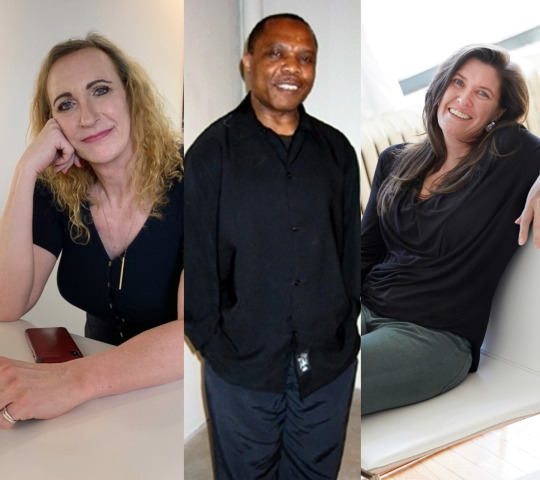
Tarrah Von Lintel, Skoto Aghahowa, and Cristin Tierney.
——————————————————————————————————
Like starting any business, opening a gallery can be daunting. For gallery owners, weathering the storms of financial crises, the ups and downs of the art market, and the rapid changes in the economic landscape since COVID-19 requires intuition, flexibility, and above all, a steadfast dedication to the mission.
While no two roads to starting a gallery are the same, Skoto Aghahowa, Cristin Tierney, and Tarrah Von Lintel each opened their respective galleries at moments of economic turmoil–Skoto Gallery and Von Lintel Gallery in the recession of the early 1990s, and Cristin Tierney after the recession in 2008. In the first-ever round-table Gallery Chat, Aghahowa, Tierney, and Von Lintel compare notes on the changes to the gallery landscape throughout the years, their advice to young dealers on navigating moments of crisis, and their paths through the art world.
What was your first job in the art world, and did it inform your career trajectory? Was there anything interesting that you learned there?
Cristin: I started in the art world at the Corcoran Museum, which no longer even exists. It was 1993. I just graduated and finished my undergraduate degree and it was the middle of the culture wars. Not long before I started there, the Corcoran canceled their Mapplethorpe exhibition under great duress. And it was complete chaos. I mean, it was a recession in the rest of the world. It was an absolute goat rodeo, but it was great if you were 22 and wanted to learn things because there was certainly a lot of opportunity. “Oh, you can type? Great. Help us with the database. Oh, you're not afraid of people? Great. We need you in this membership meeting. Do you know anything about art history? Great. Please catalog this.”
I started in the event department there and I actually began as an intern. It took about two weeks before I was hired on an hourly basis. Then I worked part of the time in events and part of the time in development and occasionally in curatorial. I saw how an institution worked; I learned what it meant to be part of a team. I also learned a lot about crisis management in my first few months working in the art world. But I think, most importantly, it really made me think about values. It really made me think a lot about why people are in this world, why do people do this? Why on earth would you stay at an institution like the Corcoran when it just seemed like the whole place was on fire?
That commitment to artists and that commitment in Washington, D.C. to freedom of speech, those were all really very present. I do think that had an outsized impact on me; it's always there in the back of my mind when I'm thinking about what artists I want to work with. It's always there when I'm making decisions.

Cristin Tierney and Alois Kronschlaeger.
——————————————————————————————————
Skoto: For me, I've always strived to be independent, in a way. I have never worked in any art institution. Really, one of the things that has always motivated me was the lack of diversity, equity, and inclusion in the art world. So, with that in mind, I started off by doing salon shows at Salon d’Afrique, a space in Harlem hosted by Rashidah Ismaili Abubakr during the 1980s. A poet, fiction writer, and activist, she regularly organizes cultural events celebrating the Black experience that attract a diverse and conscientious audience of artists and scholars living in or passing through the city.
Then, in 1990, there was a major exhibition at The Studio Museum in Harlem titled Contemporary African Artists: Changing Traditions that brought together works by about eight or nine artists living and working in the African continent. One of the aims of the exhibition was to challenge stereotypes of the “anonymous African artist.” It was a rare treat and an eye-opening experience for me, and I could relate to the works on display. I visited the exhibition several times during its run and was fortunate to meet and interact with some of the artists, as well as experience the richness and diversity of contemporary African art on display in real-time.
Also, from 1990-1991, I lived in Paris, France, where there was a very active art scene centered around contemporary African art from the Francophone and North African countries at the time, which broadened my understanding of a larger African art scene. These experiences helped propel us to seriously consider opening a space where contemporary African art could be exhibited on a regular basis in New York City, a space where art enthusiasts and collectors could engage with contemporary African art made by contemporary artists in close and intimate proximity.

Ornette Coleman, inaugural exhibition curator on opening day at Skoto Gallery, February, 1992.
——————————————————————————————————
Tarrah: For my answer to make sense, I'm going to go back a little further. I studied finance. I was an investment banker in London working for Salomon Brothers on the trading floor. Then the Lockerbie bombing happened and the guy who sat next to me on the trading floor was in that plane and that messed me up. I decided that life could be too short, and I was going to go find a job that I loved, something that I really loved to do instead. So I quit and I made a list of all the things I liked to do and art was one of them. And art won out.
I proceeded to read every book, everything that I could possibly get my hands on, and visit every gallery and museum in Paris. I'd moved to Paris also to help my father on the side. And then I got a job at FIAC, the art fair. I absolutely loved the camaraderie of the art fairs. This was in 1990, something like that, when the galleries weren't as big. There were big galleries, but one of the booths that I helped out at was Anthony d’Offay. He was on the ground himself packing up stuff and doing things. You would not see something like that today.

Tarrah Von Lintel and Mark Sheinkman at The Art Show, 2023.
——————————————————————————————————
Cristin: When you first started with the art fairs, did you feel like–when you looked around–the art fair was something that was growing and changing and that it was becoming a bigger part of the art world? Or not at that time? Did you see it coming, what it has become?
Tarrah: No. I mean, at the time, there was Art Basel, there was Art Cologne, FIAC, Chicago, and that was it for the big fairs. The fairs weren't as large and people would actually show their entire program, as opposed to now, [where galleries] are urged to show one artist or two artists because you don't want the booth to look like a fair within a fair, which I understand, but I also feel that's a pity because I think there are a lot of advantages if you can actually show your program if you're in a different city.
People in the art world always have these stories about when or where they were when they realized that they wanted to work in the art world forever. I'm wondering if there was a moment for each of you where it clicked into place that being in a gallery, specifically, was what you wanted to do.
Tarrah: For me, the art fairs made me want to be a part of that family. I wanted to be a part of that group. I loved every bit of it. And you have to remember, I came from investment banking, which is just a completely different environment; and then I made it happen.
Skoto: There were two landmark exhibitions in the 1980s that highlighted the lack of diversity in the art world at the time. One was Primitivism in 20th Century Art, organized by William Rubin at MoMA in New York, and the other was Magician de la Terre, which was organized by Jean Hubert Martin in Paris at the Pompidou Center.
Primitivism in 20th Century Art was notable for its lack of tangible input by artists and art historians of African descent. There was classical art from Africa made by unknown artists that were on display alongside works by modern Western artists like Picasso and Matisse, who drew upon aspects of primitive art and culture that were valorized. The Pompidou Centre exhibition, which sought to address some of the issues surrounding the exclusion of non-Western artists from the global discourse on contemporary art, was equally flawed in its selection criteria of works and artists from the non-Western world which privileged self-taught artists and the exotic over their academic-trained contemporaries.
Both exhibitions generated widespread criticism from the art community that helped to usher in an era of globalization in the art world and the quest for equity, diversity, and inclusion–which, in turn, invariably led to the formation of the gallery in 1992.

Skoto, Okwui Enwezor and Isaach de Bankolé, 1994 at reception for the Cote de Ivoire-born actor Bankolé.
——————————————————————————————————
Cristin: I mean, I knew from the time I was in college, and went to Paris, that I wanted to be in the art world. But I did not think that I wanted to own a gallery at all, not until I had been in this world for quite some time. It was during the financial crisis, really, in 2008 when everything sort of stopped short. The building in Chelsea that my office was in was full of art-adjacent businesses. There was a framer, photographers, and an oil paint distributor, and everybody was gone in six months [after the economy crashed].
The whole building was empty and my landlord was literally wandering the halls one day, and we got talking about all the empty spaces and all the smaller galleries that were gone. And he said, “why don't you curate some shows?” And we did. It was all working with living artists in these empty spaces. He gave me absolutely enormous spaces for free and said, “if you sell anything, split the profits,” which, it was 2009, so there were no profits, but it was a great experience and it was so much fun. I loved the strategic thinking and I loved the problem-solving.
I actually really loved working with artists. I realized that one of the reasons I never thought I would be a good gallerist is that I never thought I could say no to artists, and I never thought I could be tough enough to toe the line between “I know what you want to do,” and “here's what we should do.” I mean, I frankly think I'm still pretty bad at that and I'm pretty indulgent on the artist side of things. But I love artists and I think artists are magic people who deserve special status in our world. That's kind of where the switch happened. I decided I should open up a space and then a real estate agent called and said, “I know a great space for you.” I went and I saw the space and I said, “Yes, I have to have it.” And that's how it happened. I mean, it was really quite lucky in that way.
It's interesting to me that all three of you opened galleries in financially tough moments, right? Cristin, in the crash around 2008, and Tarrah, Skoto, I think you both have recently celebrated the 30th anniversaries of your galleries, so you're opening them in the early nineties, in a kind of economically fraught moment. And of course, may we never repeat any of those moments, but Tarrah and Skoto, do either of you feel like there was an opportunity in that moment because we were in a recession?
Tarrah: I think for me what was important when I started in the art world [was that] things were already going badly. So I was never spoiled in the way that many other gallerists were. I didn't pick up any bad habits, which I think is something that worked in my favor when I opened the gallery because I knew it was tough. I knew exactly what I was getting into. So I think, in a way, that's a much better way to start than if things are going gangbusters and then you head into a big recession. I think just keeping track of money is an important part.
Cristin: There's no indulgence. You must meet that budget because there's no help coming if you don't.
Skoto: The economic downturn at that time [actually] played to our advantage, because the first place we got was on Prince Street. It was a street-level space with a beautiful garden in the back.
Prince Street, east of Broadway and close to the Bowery, was a very good location. The Museum for African Art was a mere 10-minute walk from us, and SoHo was then the hub of the New York art scene. There was no audience for contemporary African art in New York when we opened the gallery in February 1992, and almost no one knew that Africa even had something called “contemporary African culture.” We literally had to invent an audience for our program.
The garden at the back of the gallery became the site for very stimulating, impromptu conversations among African and African Diaspora artists, writers, and scholars who were focused on the progression of modern and contemporary African art. The push for the publication of the influential NKA: Journal of Contemporary African Art in 1994 by Okwui Enwezor came out of such conversations.
How did you start to choose who you were going to show and begin those relationships when you were first starting a space and first going out on a limb and opening this space? What was that process like?
Skoto: Our first exhibition at the gallery was curated by the renowned American jazz luminary Ornette Coleman. It was a group show of African artists that included Bruce Onobrakpeya, Saheed Pratt, Obiora Anidi, and Ben Ajaero, among others. This was followed by several solo exhibitions of African artists as part of our “Art in Africa” exhibition series. Soon enough, word got around town that something different was happening on Prince Street. Many artists were interested in our program and wanted to work with us.

Left to right: Mel Edwards, Skoto Aghahowa, Stephen Procuniar, Richard Hunt, Alix du Serech and David Procuniar at the reception for Richard Hunt-Stephen Procuniar exhibition in 2007.
——————————————————————————————————
Cristin: It's funny, people are like, “how do you decide what artists you want to work with?” Well, at the beginning, you're lucky if any of them will agree to work with you. [Jokingly] “Hi, I have no track record. I've never really done this before, but I have a big building in Chelsea; would you like to show some work? I don't actually know if I can sell any of it, but maybe, I mean, we'll see how it goes. Would you like to join?”
That’s sort of how it starts. [Then] one artist leads to another artist leads to another artist. There are lots of artists and artworks that I see at art fairs or museums, and I track those people down or have conversations with them, but I do really think that part of the way that your program grows is through the artist themselves. You're just there along for the ride and hoping to occasionally have semi-intelligent input once in a while.
Cristin, do you feel like when you're thinking about an artist and your relationship with the artist in terms of their career, do you want to let it unfold totally organically, or do you see your role there as along for the ride with the artists? Do you feel like you have a position to shape it in some way or to provide feedback that will inform their trajectory?
Cristin: I think it's a partnership. As far as the content of the art or what artists make or what they do as artists, that's entirely up to them. I love to do studio visits and I love to talk about the work, and if an artist asks me, “what do you think about this?” Or “what does it make you think of?” I am a hundred percent there for those conversations. I mean, it's one of the great gifts in this world as far as I'm concerned; but when it comes to the rest of it, when it comes to conversations with museums, conversations with collectors, what are we going to show and how are we going to show it? How are we going to contextualize it? All of those things, that's a much bigger conversation. I would say that I am a little bit more hands-on with that.
It's ultimately up to the artist, but I don't think that anybody's career in 2023 unfolds organically. I mean, things can take unexpected twists and turns. Hopefully there are great twists and turns, but I think it's really important, again, as part of that partnership, if you're in an art fair and a curator that you weren't expecting walks into that booth, that part's organic, but getting that curator then into the artist's studio and signed up to do an exhibition for that artist and everything that comes along with it, that's not organic, that's my job. That's on me.

Installation view of "Mary Lucier: Leaving Earth" (Cristin Tierney Gallery, New York, January 19 - March 2, 2024). Photo by Adam Reich.
——————————————————————————————————
Tarrah, you've talked about the difference between working with younger artists and mid-career artists and how that relationship is very different at a younger stage. Could you talk a little bit about that in your program?
Tarrah: I think when you start working with an artist, you have to get to a point with that artist where there's trust, and sometimes that comes faster, and sometimes that takes a longer period of time. But once there is that trust, then I find I have yet to meet an artist who doesn't value an honest opinion. One of the problems they face is if they show their artwork to friends and family, the typical response is, “Wow, that's fantastic!” but that's really not helpful. When I critique or give my opinion, I make sure that the artist understands that I'm coming from a dealer's point of view and I'm bringing some very practical ideas to the table. It can be as simple as a horizontal format versus a vertical format, or sizes. I think that's actually one of the things that artists value the most is honest feedback, but I would never tell them what to paint.
Skoto: Some of the artists we work with at the gallery live and work outside of the US, in Africa, Europe, and the Caribbean. Some of them already have very strong reputations back home and are seasoned artists, while others are relatively young. For most of these artists, showing at the gallery was probably their first exhibition in a New York City gallery, where their works might be unfamiliar to the audience.
Artists want a direct and honest opinion from you as a gallerist, and you have to be able to convince them to be patient while insisting on the consistency and quality of the artist’s work over a long period. I still remember the first time we showed works by the Ghanaian artist El Anatsui at the gallery in the 1990s. There was practically no audience for his work at that time. Today he is among the most highly recognized artists in the world. It can take time for the audience to catch up to the work of an artist.

Aimé Mpane, "Bach to Congo," installation view, 2006-2007. Courtesy Skoto Gallery.
——————————————————————————————————
Tarrah: If I may just add in my case, because I didn't go the typical trajectory and I didn't study art history, when I was starting to get into the art world, I made it a point to become friends with artists. And even in Paris, while I was working for other galleries and I became the director of Thaddeus Ropac, I still kept all these relationships going. When I left and opened my own gallery, the first people I went to were my best friends. I had met David Row, so I showed David Row, and then through David Row, I met this group of New York artists in the New York School of Abstraction, Stephen Ellis and John Zinsser, and then Jamie Nares and on and on and on.
Cristin: It's true. It was Joe Fig, who had been my friend for years, who convinced me that I should open up a gallery. It's totally the artist's fault.
Tarrah: The reason why I opened a gallery in New York is because my artists, David Row and Stephen Ellis and John Zinsser and Lydia Dona got together and asked and said, “have you ever thought about opening a gallery in New York?” And once I had that bug in my head, I couldn't get rid of it, so I made it happen.

Tarrah Von Lintel at The Art Show 2022 with fashion icons Robert Verdi and Jerome LaMaar.
——————————————————————————————————
If you could all share what your advice would be to an aspiring dealer in 2023, what would you say?
Skoto: I tell them to stay focused. Don't look for that quick, short-term return. It is long-term, strategic planning, so stay focused. I always tell them to be deliberate in their decision-making process and be confident in their decisions. You must learn to make up your own “Top Ten.” Don’t let anybody impose theirs on you. Don't listen to what anybody's telling you in terms of what is trendy and what is not trendy. Just believe in yourself and go with it. Be honest and deal with what it is. Do what is right. Do what is right by you and what is right by the artist.
Cristin: Something that I always say to people is never forget who your first and most important clients are. It's the artists. You have, of course, also clients who are acquiring their work and supporting their work. But you should always think of your artists as your clients and do for them just the same as you would do for the collectors and the curators and everyone else. You represent them. You should always have that set of clients’ best interests at heart, first and foremost.
The second thing is something that somebody told me; Charlie Moffett Sr. and I had a conversation years ago. We were talking about an older generation of dealers and how they did what they did. And essentially, to him, the common thread was that their client bases were not necessarily broad, they were deep. Those people, if you treat them right, if you invest in them the way that they're investing in you, intellectually and emotionally, not just financially, they're going to support you.
I think that's a really important thing for the long-term success of a gallery. You want to focus on having relationships that are deep rather than broad, because that broader audience or market might be gone tomorrow. They might get preoccupied with NFTs, or if the stock market plunges, they're out of there. But the relationships that run deep, the relationships that are formed with people who believe in the same sorts of artists and artworks and the same sorts of values that you believe in, they're with you for the long run, and that's the depth and that's what you need to stay alive for decades, rather than years or months.

Cristin Tierney Gallery artists on a Zoom call with gallery staff during the Covid-19 lockdown.
——————————————————————————————————
Tarrah: I have two things to say about that. I do think that the artist is your biggest asset, so treating the artists with respect and paying them is really important. I believe that I have a very good reputation in dealing with artists. I'm paying them. And so when I approach a new artist, they're going to ask their friends, and then their friends say, “Well, we've never had a problem.” I think that's really important.
Cristin, my experience with the deep versus broad has changed. It used to be deep, but since COVID-19, it has moved to broad. Most of the people who were the deep collectors in my case, stopped in COVID.
They didn't like the digital art fairs or the digital viewing rooms, and the fact that the social part of the art market was completely removed, they lost their interest because they didn't need more art. I mean, these people have so much art that they have warehouses full of it. So I've actually been fighting with this problem–I had deep relationships, but I'm getting calls from them now saying, “I bought this from you 29 years ago. What can we do with it?” So then you try to either resell it or you try to have it donated to a museum, which makes everyone happy, but that's a tremendous amount of work for no money.
Cristin: Did the heavy emphasis on digital outreach broaden your client base? It did somewhat for us but I didn't find that it was a huge amount the way that you read in some of the publications for us.
Tarrah: No, I can't say that that's the case. In terms of broadening, I don't have this core, really healthy, strong core group of collectors anymore. I now am selling just to a wider audience, but not as deeply. Not as much. I mean, I wish that would change, but the younger generations, they're not “the crazy collector.” For me, a collector is somebody who keeps buying even though they can't hang anything anymore. I find that a lot of the buying that's happening now is either for investment purposes or for the piece above the couch.
Cristin: Yeah, it's not patronage in the same sense either. It's not about supporting an artist, really.
Tarrah: No.
Cristin: Yeah, there's a lot less of that, sadly, I think. Skoto, what's your experience been?
Skoto: Unfortunately, art has become something of an investment rather than just buying work because you like it, because it's something that you want to live with for a long, long time. My experience has been a mixed bag. Thankfully, you have some collectors who still buy work because they want to support what you're doing and because they like what you're showing.
At the same time, you also have collectors who come in and sporadically buy work, because they figure it is something they can flip in a few years and make a fortune out of it, which is unfortunate because it just kills the spirit for both the artist and the dealer. But that's the world we live in now.
How do you feel like your conversations with your clients have changed as the digital landscape has changed over the course of the last three years?
Tarrah: I mean, one of the big problems now is getting people to actually look at work in person. The difference between a two by three inch .jpeg and a work of art that's six feet by eight feet, that doesn't translate. I keep thinking that I should rename the gallery to “Does Not Reproduce.”
Things may be larger in person than they appear.
Tarrah: Well, yeah. I actually had a show during COVID, a group show that I called Does Not Reproduce, and it's all work that just did not work on a screen–size, texture, any kind of depth didn’t show.
I believe that a good artwork is one that grows with you over time, so you have a long dialogue with it. That's what makes it really good. But that's exactly the opposite of what's happening at the moment. People are looking at, myself included, thousands of images every day. When I started, there were five ways to see art. You could either go to a gallery, go to a museum, buy a book, buy a magazine, or make the art yourself. But those were your choices.
Skoto: Yeah. Well, slides were also available at that time, too.
Cristin: And transparencies! But I feel like I have to agree. It's hard to get people in front of the work. Once they're there, though, the amount of time they're willing to spend talking about the work is still substantial. And I don't think it's just an older generation. I do think that there are a lot of younger people who come to galleries wanting to have those conversations, wanting to get away from screens and TikTok and attention-distorting social media programming and stuff like that.

Installation view of "Alois Kronschlaeger: Allotropisms" (Cristin Tierney Gallery, New York, January 13 - February 19, 2011). Photo by Marc Lins.
——————————————————————————————————
Tarrah: I mean, I do feel that COVID had one positive outcome, because in 2019, things were very much going towards social media and [as a result] less people were coming to galleries. Because of COVID, everyone looked at their phones so much that [they’re all] sick of it now. So now when they come to the gallery, they don't lead with the phone anymore, which, in 2019, they were looking at their phone while walking through the gallery. I feel like people have put away their phones when they are now experiencing something, which I'm very happy about.
Skoto: One thing we've done after COVID is to have a longer duration for our exhibitions. Prior to COVID, most exhibitions were usually four weeks, five weeks. Now, you find that galleries are more willing to extend their shows. I remember [in March of 2020], we just opened a show when COVID came along. We had to keep the show up for nearly a year, which was a smart thing to do because we ended up almost selling the whole show by the end of that year. In a way, I think it has allowed us to readjust and to make changes to things that we used to do. Another way to get around this short attention span is to figure out how to join them. You should have a stronger presence online. Of course, because we are all saturated with images and media, very few people respond.
What advice do you have for people who are aspiring collectors who might come into your gallery?
Skoto: Make them feel comfortable and provide them with as much information as possible when they come to the gallery. Taking that bold step to come to the gallery, that's something positive. You should always try to help them understand and engage deeper with the work you have on display. Follow up and communicate with them.
So you really encourage them to ask questions. That for you is a vital part of building that new relationship with the collector.
Skoto: Oh, yeah. You should always strive to get their opinion about the work they are looking at or interested in. Let them tell you in their own words what they think about the work or an artist.
Cristin: What I always say to our younger groups is that, first of all, you should never be afraid to ask somebody to come talk to you about the work in a gallery. But when you’re there with somebody who knows so much more than you do about the work–and you are kind of nervous and it's intimidating to even think about questions to ask–one question that I always suggest is, “tell me something about the work that I can't read in your press release. Give me a way into the work right here, right now, that goes beyond what I can read on my phone.” It's a powerful, useful question because that person in front of you probably has so much information about this exhibition and about the artist's work.
It also doesn't require you to have a tremendous amount of information, but it does enable you to get to a point where it's not just about, like Skoto said, what they're reading on their phones or what they can find online. What's here that I can't see and understand any other way? It's a pretty simple thing, but it's also kind of empowering, right?
Tarrah: I find myself trying to get them to have a dialogue with whatever it is that we're looking at. I know the things that are important that I can draw people's attention to. I'm sort of becoming the teacher in how to look at this, how to experience this, just to involve them, to pull them into the story. And then of course, by telling stories, the next time they see something, they become the teacher, which makes them feel good. It's like when you see people recognize an artist at an art fair, they're the happiest people.

Tarrah von Lintel with the artist Miles Regis during his last show at the gallery, titled ‘Better Days Ahead’
——————————————————————————————————
Cristin: Totally true. Totally true. I actually remember when my husband and I were really young and we didn't really have very much money. We started buying art and we bought this work that we hung in our living room area of our first home together. He never said much about the art, but his friend from high school was there one day and started asking him questions about the art; and as you said, Tarrah, he knew all the stories. He knew all the details because he listened to me so many times and talked to the artist so many times and he just could not tell his friend enough information about this artwork. I'm sure his friend was like, “Okay, that's enough!” Again, it's like you said, there's something very empowering about that, about recognizing and knowing like, “Hey, I know something about this.”
Tarrah: We're all storytellers.
Cristin: Question for the group: why did you guys want to join the Art Dealers Association of America? [Says Cristin, the head of the Membership Committee.]
Tarrah: Good question. I mean, frankly, a big draw I think is The Art Show. The Park Avenue Armory is one of the nicest places to see art in, because of the location and the size of it.
Cristin: I agree.
Tarrah: And now that I'm in it, what I truly love about this organization is the professional way that everything about it is handled. It's fantastic. It doesn't happen often enough.
We aim to please, Tarrah!
Skoto: I think the recognition by your peers that what you’re doing is relevant… that's a big plus. To be able to, from time to time, stay in touch with your peers who are doing the same thing, I think that's a big motivation to join the ADAA.
Cristin: It's like getting an award from the Screen Actors Guild, because the Screen Actors Guild is the award that your peers give to you.
I have to agree that the peer recognition is immensely gratifying. And [so is] the sense of community that you have as part of the organization. I think especially we're talking about a world that's increasingly fragmented, and the distance that we all feel between our clients and our colleagues, and what living on a world of screens has done to us, and the ADAA is a kind of remarkable antidote to that for all of us, right?
——————————————————————————————————
Skoto Aghahowa is the founder of Skoto Gallery, located in the Chelsea neighborhood of New York. Aghahowa founded Skoto Gallery in 1992 as a space where works by African artists are exhibited within the context of a diverse audience.
Cristin Tierney is the owner of Cristin Tierney in New York. After years as an art advisor, Tierney opened her eponymous gallery in Chelsea in 2010. In 2019, the gallery moved to the Lower East Side.
Tarrah von Lintel is the founder of Von Lintel Gallery. After years in Paris at Galerie Claire Burrus and Thaddeus Ropac, Von Lintel opened her own gallery in Munich in 1993. The gallery moved to Chelsea in 1999, then to Los Angeles in 2014.
1 note
·
View note
Text
“Remember That What We Do is Bigger Than Ourselves" - Jessica Silverman on Building Relationships, Collaboration, and Strategically Navigating the Art World
by Kim Cabrera • April, 2022

Jessica Silverman, photo by Stan Olszewski / SOSKI Photo.
——————————————————————————————-
Jessica Silverman has always found a variety of ways to utilize her curatorial eye, beginning with mounting shows in a small local vitrine and a basement project space while still in school. In 2008, after graduating from California College of the Arts with an MA in Curatorial Studies, Jessica opened her first official gallery on San Francisco’s Sutter Street. Since then, she has built a roster of local and international artists, created strong relationships with curators and collectors in San Francisco and beyond, and most recently, moved into a new, expanded space in San Francisco’s Chinatown.
We sat down with Jessica to discuss, among other things, her entry into the art world, the San Francisco art scene, and the various changes her gallery and the art world at large has faced over the years.

Installation view, Woody De Othello: Looking In, 2021, photo by Phillip Maisel.
——————————————————————————————-
When was the first moment you became interested in the visual arts; was there one singular “aha” moment or did that interest evolve over time?
I think it’s fairly public knowledge, but I grew up around my grandparents who collected art — Fluxus in particular — and I remember distinct moments when I knew I loved art and was interested in who the artist was and why the collector collected.
One of those moments was when I met Yoko Ono. I remember thinking, “She’s so cool. Artists are cool.” And also really unique and individual. When I grew up in Michigan, I went to this college preparatory school and I was kind of an outsider since I was one of the few people interested in the art department, so meeting an artist who was so much herself was appealing to me, and I thought “this is a world I want to be part of.”
You had originally started out as an artist yourself?
Yes, very early on. I spent a lot of time in the darkroom at my high school and then I went to Otis College. About a year into Otis College, it was very, very clear that I wasn’t going to be an artist. It was important for me to go through that, and then have my teacher say, “I think you’re really more of a curator, your interests align more with curatorial work.” From there, I started investigating that as a path forward for myself, and wound up at California College of the Arts for curatorial practice.
In relation to your grandparents’ collection — did you go with them to visit artists, or to studios or to galleries, or did you just experience the art through the physical collection?
I went to Washington, D.C. and New York with them a few times and we visited museums and galleries. We used to go to Max Protetch’s gallery, because my grandfather and he were good friends. I also saw the works at the Detroit Institute of Arts, at their house, and within their private collection stored in downtown Detroit.
Would you say that the experience seeing art with your grandparents helped shape some of your ideas about how to view art, or the critical lens through which to view it?
I learned the importance of “need to have and can’t live without.” The empathy that I try to bring to my relationships with collectors was also informed by my relationship with my grandparents.
Initially, in dealing with my grandparents, I didn’t think a lot about the curatorial until much later when I was already on that path. They had always been very engaged with everything that Jon Hendricks did for them. Jon was guiding how they built their collection, and creating the systems to organize it. His use of systems and categories engaged me further in the curatorial.
Could you tell us a little more about that project space you opened in a basement in your early days, how that came to be?
Even before I had my space, I had a little vitrine that was outside a building —the kind you put notices in. I rented one in San Francisco and put on little shows until I had a break-in. Then I was done doing that.
After, I opened my basement space, which was not a formal gallery, but a project space I ran in 2006 during grad school. In 2007 I graduated, and in 2008 I moved to Sutter Street, where I started to formalize the gallery and think about what it meant to represent an artist.
Who were some of the gallery’s first artists, and how did you go about making the decision to start working with them in a formal way?
I grew up in Michigan with my friend Job Piston, who is a photographer. He was graduating from CCA in San Francisco, and he did a show with me. I asked him to organize an exhibition of artists that he was interested in, or learned from, so we had Larry Sultan and Tammy Rae Carland. Tammy Rae joined the roster and her show was the first we did in our Sutter Street space. She’s now the provost at CCA, but still an important part of our program.
When you were starting out and you were younger, did you find that you had to convince people to buy from you, or convince artists to sign on?
Totally. I did feel like I had to convince people. I didn’t really mind until it became frustrating. I didn’t want to go through my grandparents, and didn’t want what I did to be determined by who they knew, so I was pretty stubborn about going about it my own way.
I had tons of relationships that didn’t work, where I’d put an artist in a group show and they would decide that they wanted to wait for someone bigger — and, not to toot my own horn, but oftentimes those artists never found anyone bigger. For me this is very much a relationship world. When people aren’t willing to invest in the relationship in the same way as I am, it invariably doesn’t work. Maybe I was initially upset or irritated, but long term I’ve never felt resentful about a relationship that didn’t work out.

Installation view, Hayal Pozanti: Lingering, 2021, photo by Phillip Maisel.
——————————————————————————————-
When you first started the gallery, did you have a clear vision of what you wanted the program to be, or were you a little more organic about that process, and let the artists you were interested in drive that?
I definitely thought I had a clear vision, but in retrospect, I don’t think I did — I was young and figuring it out. I would say that something that’s always been important to me is the relationship between the conceptual rigor of a practice and the visual results. I’m very interested in the way something is made, and the nature of how the artist got there.
Did you find that when you were talking with artists, because you originally came from that creative background, even if you didn’t necessarily spend a lot of time doing that, that they opened up to you in a way that maybe they wouldn’t necessarily have?
Yeah, maybe. I think I’ve always had a lot of empathy for artists, because I had a studio practice for some time and try to remember how daunting it can be to be vulnerable, transparent, and raw with visitors.
You talked about a sense of empathy for collectors, and being empathetic towards who the collector is and what their needs are. Are there certain things you always like to make sure of, certain ways the collector is taken care of beyond the traditional transaction itself?
Yes. I’m constantly reminding my colleagues about the relationship. Many of our collectors date back like 10 years of working with me, and it’s one of the things that people who are new to the gallery realize.
We try to be a gallery that really fosters long-term relationships with our artists, our collectors, and the curators we collaborate with. I see no reason for a collector relationship to go sour because of miscommunication, so we try hard to be as communicative, transparent, and helpful with collectors as possible to achieve what they need.
Someone asked me the other day, “What do you love to do most?” I said, “I love selling art.” Not in a transactional way, but in the sense that I sold an artwork to someone that they’re excited about, and when they get to meet the artist, they get to be so happy that they bought this artist’s work and they’re supporting it. I just love watching that play out.
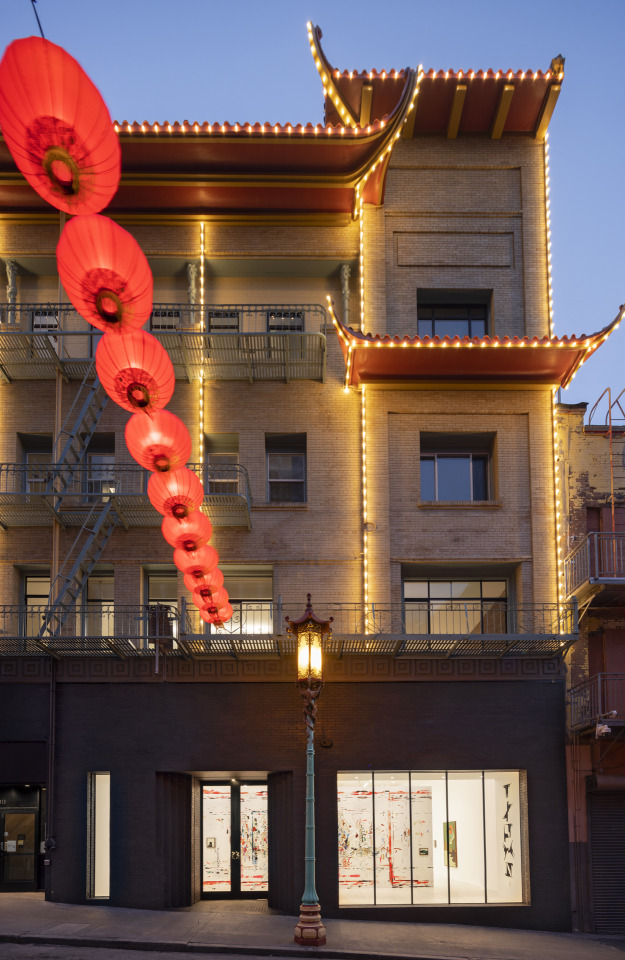
Exterior of Jessica Silverman, San Francisco, photo by Henrik Kam.
——————————————————————————————-
You recently moved to your new space in Chinatown. When is the moment you knew that shift needed to occur? Again, was there one moment or did you kind of come to the realization over time?
I found the new space in November of 2019 and in January 2020 I signed the lease. We had been outgrowing the gallery space for some time. Since 2019, I knew I wanted to move, especially in terms of where the staff was sitting and the overflow in the storage room.
A lot of your artists haven’t had a chance to have their show in the new space, but as you start to learn the bones of the space, the way the light is different at different times of day, do you share that with them? Or do you let them discover that on their own?
Ideally anyone who’s having a show comes and sees the space before. For Hayal Pozanti’s show in January 2022, that [didn’t] happen, but fortunately for us she’s a painter so it [felt] fairly easy to strategize.
We’re talking to Martha Friedman about her [forthcoming] show. I told her she might want to visit because she would like to show these new lightboxes she’s making, so we’re trying to figure out — how much light will bleed into the space? Is there anything we need to do in advance to ensure that the works will look like how she envisions it?

Martha Friedman, Nerve Language 8, 2020, photo by Kristine Eudey.
——————————————————————————————-
What role did the neighborhood itself play in the move?
I was very interested in being part of a neighborhood that had a strong sense of self. And I love the connections I’ve made here — everything from the foot police who walk around and constantly make sure people are safe, to the chocolate place next door who we send visitors to and vice versa.
Looking at the art community as a whole within San Francisco and viewing that in contrast to, for instance, New York or LA, what would you say are some of the best assets that the San Francisco gallery scene has that those other two large cities don’t?
I think it’s a good question. I sometimes feel like I’m a little bit on an island here. My biggest anxiety is that San Francisco is read as a local and provincial art scene, but I don’t feel like it is or at least, that’s not my relationship to it.
One of the nice things about San Francisco is how close and friendly the gallery scene is. For instance, after I speak to you I have to call Claudia Altman-Siegel, who wants to ask something. Jeffery Fraenkel is one my closest friends, and Tony Meier and I share an accountant who he graciously introduced me to. I took John Berggruen to lunch the other day. That’s kind of the scene.
And the museums — Claudia Schmuckli is a really close friend, Jenny Gheith and I share the same birthday and get together frequently. I'm very close to Ali Gass, who’s starting the ICA SF, and Susan Sayre Batton, at the San José Museum. I consider some of them as my best friends.
And did these relationships factor in to the project that you all created, the 8-bridges platform?
A lot of that came out of conversations a smaller group of us had. We thought — ok, we’re pretty good at getting out-of-towners into the gallery when they visit, but what if no one comes into town? How do we transact, what does that look like? Is there anything we can do to spread the word about what is happening in San Francisco? And that’s where that came from.
As the world re-opens, we’ve been caught in the middle of transition. We’ve all gotten pretty busy and we’re trying to figure out what 8-bridges looks like when things progress.
Speaking of reopening, and the idea that you’re going to art fairs and other places and the international aspect is starting to open up again, did you find, when you first opened the gallery, that there was a receptive audience in the Bay Area to your international artists, or was there a lot of teaching and education your clients in terms of them starting to build collections?
That’s a good question. There are collectors that I almost feel like I advise — we talk a lot about what they’re looking at and where they want to put their energy. I’ve actually hopped in the car and driven around to look at art with those collectors — it’s more educational.
But there is a pretty prolific collection of advisors here and I would say that the advisors do a really good job of ensuring that collectors are knowledgeable and expansive.

Sadie Barnette, Family Tree, 2021, photo by John Wilson White.
——————————————————————————————-
In the 15 years since you began — for now, let’s leave the last 18 months out of it — the art world has changed massively. How have you had to adapt the gallery to those changes, be they the speed at which the art world works, or the new digital landscape?
It’s so funny because I think a lot has changed, but I also think in some ways, very little has changed. We still schlep things around the world and show them to people. I guess now there’s a little more done on the phone, and so there’s a little less schlepping in advance of the commitments, and obviously digital platforms have allowed for online sales to become achievable.
There’s still not as much collaboration amongst dealers as I would like to see. I think that institutions still have a hard time getting budgets to buy art. But on the positive side, I think that because of the internet the world has gotten a little bit smaller and therefore artists — like for instance, those we represent — get to be well-known more quickly, from a curatorial point of view.
Do you find that there’s lots of talk now about who the new, young collectors are going to be? Certainly that comes up around tech and art and NFTs and the like. Have you found that there’s a consistent kind of series of traits with a younger generation of collectors you’re engaging with, or is it that everybody’s very different and unique in their own right?
I think everyone’s pretty different and unique in their own right. One of the things I’d say is that a lot of the collectors that we deal with are fairly eccentric and don’t just collect one thing. I just had a call this morning with a collector who asked me if I’d ever come across an artist called A.Y. Jackson. He’s a Canadian painter who died in the ‘70s. [The collector] is Canadian, and really connected to the landscapes he painted.
People are very individual here, especially if they don’t work with an advisor. I find that the collectors are not really following “what’s hot,” which is refreshing.
Often in NYC, back in the day, collectors would inherit the board seat at the Met or the MoMA from their parents and so it stayed in a very siloed lane, but would you say that in fact, collectors are a broader, more diverse range of people than what we experienced in the art world in the earlier days of your career?
In some ways. I tend to be drawn to collectors who march to their own beat, kind of like I do. Over time, for me, I’ve been able to weed people out quickly. In the older days, I just sold things to those who wanted to buy. Now, I place things.
And speaking of young collectors just getting started, what would you give as advice for someone who’s never bought before or is just dipping their toe?
My advice is to look at as much as possible. Finding a way to trust your instincts, which is kind of how I operate, is the best path forward.

Installation view, Woody De Othello: Looking In, 2021, photo by Phillip Maisel.
——————————————————————————————-
You’ve talked previously about discussing with an artist when you might raise prices as their career moves forward, and one of the things you encourage is a sense of patience about that process. Can you talk more about how you go about making that decision with the artist?
I have this anxiety that once you go up, it’s hard to come down. We try to raise prices in a very restrained and thoughtful manner. A good instance of raising prices is an artist having a museum show, that would give us the credibility, I suppose, to raise prices 10–20% from where they’re at.
But we try not to be overly excitable. Woody De Othello— he’s 30 and still a young guy, but the demand for his work is tremendously strong. We could be selling things for far more than we do, but that doesn’t really benefit him in the long term. We’re interested in helping shape a long, stable career, and not what’s right in front of us. We try to be intelligent about the ways we build artist pricing structures.
Would you say there’s a foundational strategy when you start working with a young artist, that there’s certain things you, or they, need to do to help build the seriousness of their place within the art market?
Well, I think it takes both parties. Sadie Barnette is a great example. She works super hard and is really strategic, smart, and connected. She nurtures those connections, she thinks deliberately about the placement of her work, like we do, and we’re able to continuously bring in important voices to support the practice together.
We try to balance our time between strategically placing things with private clients who are on museum boards in order to sell things to museums down the road. We found that museums often don’t have budgets to buy what they want themselves, so building the collector relationship for the artist is important to ensure that the museums can find buyers for the works they want to bring into the collection. We do a lot of matchmaking.

Sadie Barnette, Home Good: Couch II, 2019, photo by John Wilson White.
——————————————————————————————-
As you’re talking about the pricing of artists’ works — are there times where you have to play a restraining role, be the patient one, because you see this long game ahead of you that maybe an artist who’s starting out isn’t really aware of?
I have to say, artists are pretty trusting so we don’t get a ton of pushback on things. When we’re like “Hey, let’s wait and see what happens,” or “We’re not going to offer this now, we’re going to save it for X,” our artists support us, thankfully. Otherwise, it would be challenging. But it doesn’t mean it’s not hard on our part.
We have another question for you that’s kind of unique to your position here at the ADAA. You’ve been an amazing part of the ADAA Membership Committee and I’m wondering, for you, what was meaningful about becoming an ADAA member?
Well, I talked about how collaboration is something that’s really important to me. The ADAA really nurtures that, encourages it, and kind of insists on it; that is a really appealing component of what the ADAA brings to a gallery who has the option to be involved.
The Art Show is one of many collectors’ favorite fairs to go to because it’s more like an exhibition; it’s so deeply curated and considered, and the experience of that week is a really cohesive one. People come back day after day to experience it, repeatedly.

The Art Show 2021, photo by Scott Rudd Productions.
——————————————————————————————-
When we originally asked you about how things have shifted in the last 15 years, we said let’s leave out the last 18 months. But now, let’s return to that period. Obviously, we are still processing the pandemic, but are there a couple things that you’ve learned in the last 18 months that have either surprised you about the market, or your business in particular?
The market’s been kind of insane. It’s been a bananas year in terms of business. There are supply chain issues across all parties — galleries, artists, construction workers — involved.
Our collectors, early on in COVID, stepped up and bought art from us even when they had no idea, like all of us, what was going to happen.
I would also say, with the onset of NFTs and cryptocurrency, we’re seeing an influx of younger voices — they’re not all buying great contemporary art yet, but they are coming to the market.
There was a lot of talk amongst our members, as well as the press, asking, “Is this the end of the physical gallery space? Who needs a physical gallery space if this whole digital online presence works out?” Would you say the last 18 months have proven that we still need the physical interaction with the work?
I do. Sarah [Thornton], my partner, has written a lot about this. In the past, there was this thought that tech people would like digital works, but actually that’s not really true, because they are at computers all day.
It seems like tech people like mediums like sculpture because of the reassurance and enjoyment of being a body in space and looking at something physical in relationship to themselves.
Is there anything else you wanted to make a point of mentioning or any other advice for young dealers or collectors you think we should impart?
I would say, remember that what we do is bigger than ourselves. Do things for the right reasons and choose collaboration rather than thinking you can do it yourself. That has always been the best advice I’ve given myself in order to pursue success.
——————————————————————————————-
Photograph of Jessica Silverman courtesy Jessica Silverman, San Francisco. All gallery and artwork images courtesy the artists and Jessica Silverman, San Francisco.
4 notes
·
View notes
Text
“People Realized the Need to Make Connections Along the Whole Spectrum of Art History” - Leon Tovar on Latin American Art
by Kim Cabrera • April, 2021
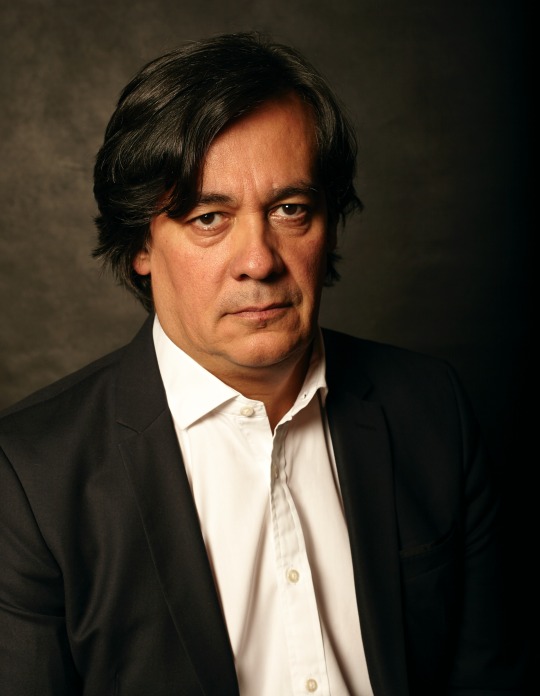
Leon Tovar, photo by Andres Serrano.
-------------------------------------------------------------------------------------------
Leon Tovar has been bringing important 20th-century Latin American art to an American and international audience for years – but that wasn’t always the program of Leon Tovar Gallery. When Leon opened his first space in Bogotá in 1991, he was focused on showing a roster of North American and European artists such as Sol LeWitt, Bernar Venet, and Josef Albers. It was only after moving to New York in 1998 that he realized there was a niche to fill: “I got the idea to make clear the real connections between Latin American artists and broader art history… I started to work here and present important programming featuring Latin American artists in different areas – geometric abstraction, optical, kinetic.”
Now the gallery, which is celebrating 30 years in business, is firmly focused on educating collectors about Latin American art and broadening the scope of the art historical canon.
We sat down to talk with Leon about the need to make cross-cultural connections throughout art history, the responsibilities of dealers and collectors, and the evolving role of digital tools in today’s art world.
When did you first become interested in visual art?
My experience with art started when I was around 7 years old. My father—who was a prominent lawyer in Colombia and a very intellectual person—used to paint over the weekends. And my mother, she always saved money to buy small pieces of art. From the beginning we had paintings on our walls and I was really passionate about that. When I started to paint at 8 years old, I was like a mini artist. And from that period I started to learn to be involved in the arts all my life. I never did anything else; that was my only career from the beginning.
When I was young there was an exhibition at the Museum of Modern Art of Bogotá, and it was one of my first exposures to geometric abstraction and optical art. A Venezuelan artist had been invited by the museum, probably Carlos Cruz-Diez, as he had a show there in 1985. After that, I became really passionate about how people can, with plasticity, communicate and express different ideas.
I went to Andes University to study art history, and when I was probably 18 or 19 years old I did an internship at a gallery in Stockholm. After that, when I was in my mid 20’s, I opened my first gallery in Bogotá in 1991 – as of this year we are 30 years old.
Early on, I was inspired after being invited by Sol LeWitt to his studio in Hartford. For my gallery in Bogotá, I started a program that brought international artists to the Colombian public, because it was difficult for people to go to museums in the States or Europe.

Leon Tovar at Sol LeWitt’s studio in Hartford, Connecticut, late 1980s.
-------------------------------------------------------------------------------------------
How did you meet Sol LeWitt originally?
My sister was also an art dealer, and she was married to a Swedish dealer. Together we started to make a plan for the gallery’s program. As I mentioned, very early on I was impressed with geometry, minimalism. We thought it was really important to bring LeWitt to Colombia.
He was really interested in doing something in Latin America because he had only been in one small show that had traveled to Bogotá, São Paulo, and Rio de Janeiro in 1975 – that was his only approach to Latin America. So, he invited us to his studio in Hartford. I was really impressed because he knew a lot about Latin American artists, especially those that we have worked with for many years, like Carlos Rojas, Eduardo Ramírez Villamizar, Edgar Negret. At that time, those Columbian artists were not even popular in Latin America or their own country.
The first show at the gallery ended up being Bernar Venet and Sol LeWitt.
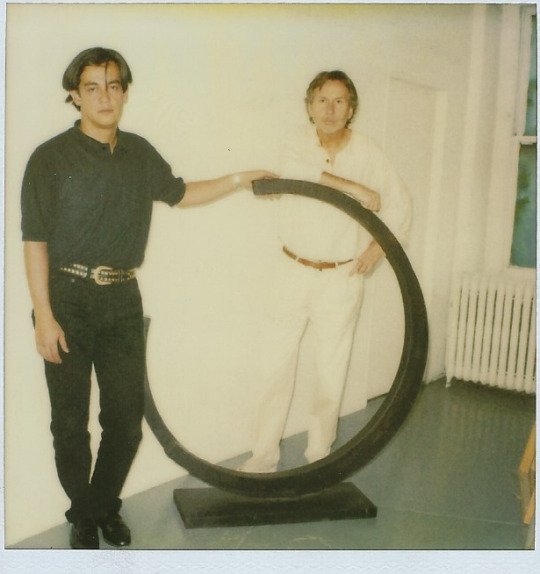
Leon Tovar with Bernar Venet at his studio, New York, 1992.
-------------------------------------------------------------------------------------------
Since those artists didn’t really have exposure in Colombia, did you find that people understood their work right away, or did you have to educate the public about them?
Their work divided people, immediately.
People who knew a lot about color theory, the theories of Josef Albers, understood. And later, we did an Albers exhibition in Bogotá, and people were thirsty to learn. Bogotá was a very well-known city for literature and art, and we have great artists there, but people didn’t have the same access to information. The budgets of museums were very limited.
A lot of people didn’t understand the work. If I sold a wall drawing by Sol LeWitt, and after the buyer received a certificate, and were told they needed to bring people to remake the wall drawing at their own place, they would ask, “Is this real?”
But the press was really good to us back then and we got a lot of articles all over Latin America. Venezuelan collectors started to buy from us. They sent curators to see our exhibitions and that’s why I survived this adventure. People thought it was a great idea to bring New York artists to Colombia and provide the public with access to their work. And on top of everything else, people could purchase the art if they liked it. We quickly became very popular in Latin America.
When you came to New York, did you find that these American artists you had shown in Colombia were already known and represented? Did you have an idea of representing them when you came to New York, or did you plan to bring Latin American artists to the States?
In 1998, I decided to move from Colombia to New York, both to gain another perspective for the gallery and because the situation had gotten so bad in Colombia that it didn’t make sense to continue in Bogotá. I moved to New York with the idea that the program would be more or less the same as it was in Colombia. But when I got here, Bernar was with André Emmerich Gallery, Sol was with Paula Cooper. I knew that now I was in the big swimming pool, and I got it immediately and I didn’t produce any resistance.
So I got the idea to make clear the real connections between Latin American artists and broader art history. Sol taught me there were no walls, no borders. He knew exactly who Carlos Rojas was, and the names of other Latin American artists that only professors knew. Then I understood there were no limits to the gallery’s program. I started to work here and present important programming featuring Latin American artists in different areas – geometric abstraction, optical, kinetic.

Leon Tovar Gallery, East 75th Street, New York. Photo by Peter Baker.
-------------------------------------------------------------------------------------------
Did you feel there was a lot of education you had to do with an American clientele, or do you think there was already an understanding here of Latin American art and its importance?
I had an advantage – I already knew how American artists worked, how European artists worked. I came here and learned a lot in the auction houses. I learned that we need to be very well-prepared with art historical knowledge in order to develop our program because most people have better ears than eyes. We need to explain to people how, why, optical art has been important. Why Yves Klein’s favorite artist was Jesús Rafael Soto. Why the Zero Group had connections with Latin American artists (one of the entrance pieces at the Guggenheim Museum for the Zero Group exhibition in 2014 was a Jesús Rafael Soto work). There are hundreds and hundreds of real connections, and this realization started from this chat with Sol LeWitt.
Museums started to become inspired, and in 2002, there was Body & Soul, one of the first important shows of art from Brazil at the Guggenheim Museum. It was probably among the earliest serious examinations of Latin American art.
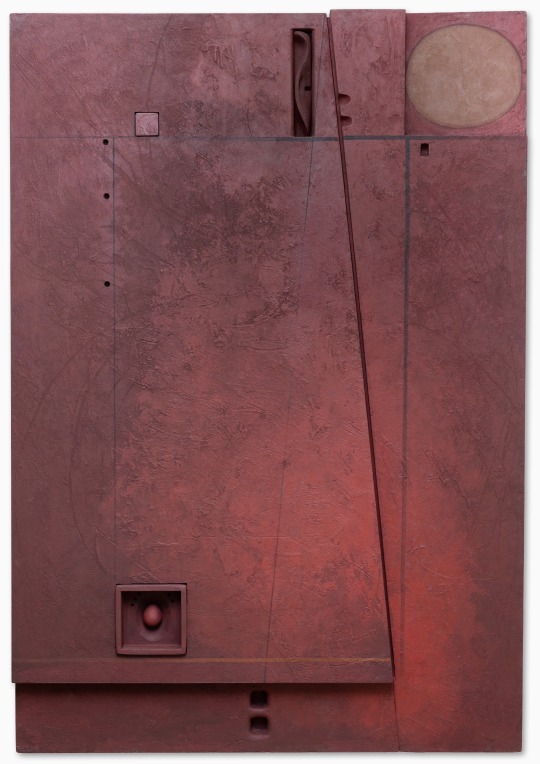
Marcelo Bonevardi, Rampart, 1969, acrylic and charcoal on textured substrate on wood, © Estate of Marcelo Bonevardi.
-------------------------------------------------------------------------------------------
Do you see yourself as filling in gaps in the art historical narrative?
If you’re a collector – a real collector – you need to find complements to your collection.
You can’t build a collection of Surrealists if you don’t include Frida Kahlo, Leonora Carrington, Wifredo Lam, Roberto Matta. You cannot talk about geometric abstraction without Carlos Rojas, Carmelo Arden Quin, Lucio Fontana. You cannot talk about Impressionism without Armando Reverón, Andrés de Santa Maria, because they were Impressionist artists also. If you are a landscape collector, you go to the School of Barbizon, but you also need to see the School of Quito. The light in Bogotá is the same light in Biarritz; the landscape artists have a connection over thousands of miles, even if they don’t know each other.
As a collector, you need to develop this expertise. If you don’t, it’s difficult. The gallery does a lot of work—we have a lot of space to cover, and thousands of collectors don’t have this knowledge of Latin American art. That’s why we started to be important, because people realized the need to make connections along the whole spectrum of art history.

Leon Tovar Gallery at ADAA’s The Art Show, New York, 2020. Photo by Nicolas Manassi.
-------------------------------------------------------------------------------------------
When you come to a new geographic region and you have to build a market for an established artist from elsewhere, you’re really building the market from the ground up. As the business owner, that is a long-term strategy and that doesn’t happen overnight – so here you are, starting a young gallery in the US, and you’re having to create a long-term view for it that may not have immediate financial benefits.
It’s a huge sacrifice. Huge. As difficult as it was to bring Sol LeWitt or Josef Albers to Bogotá in the late 1980s or early ’90s, it was just as difficult to bring artists like Carlos Rojas, or Eduardo Ramírez Villamizar, or Carmelo Arden Quin, or Sergio Camargo to America. And obviously New York is a very competitive city, but we love that type of competition.
Some of the artists we worked with in the beginning didn’t have any museum exhibitions or any really important approval from collectors. Over time we saw that change, and we saw their prices rise. We’re working with the most important of these big artists from Latin America. They are part of the art world, and there’s no room for speculation.
There are of course a lot of people that deal art for passion, knowledge, and education. And when people are really passionate, they never give up, even if they’re not economically successful. Obviously, the economic part is important, because you need to survive. But if you focus on one specific area and develop that knowledge, build the right program with the right artists, this will bring you success, sooner or later. It may take a long time, but don’t be stressed about the economic part because it will come; if you have a serious vocation, people will start to recognize that.

Leon Tovar with Jesús Rafael Soto and Carlos Cruz-Diez, Caracas, Venezuela, 1993.
-------------------------------------------------------------------------------------------
Is there any advice you may have for new collectors?
Like dealers, there are different kinds of collectors.
Some young collectors are interested in collecting because they saw it in their own families and they want to continue the tradition, which is fantastic and beautiful.
Another type of young collector sees a business opportunity. That’s important, too, for the market. But if you want to build a long-term project, and want the dealers and galleries to respect you and give you the best information, you need to act responsibly as a collector. You have privilege, yes, but also obligations to the galleries and to the art that you buy. There are protocols that you need to follow. It’s a big responsibility. It’s more than people think.
If you educate yourself, you will always be a successful collector. You need to learn a lot, read a lot, go to museums. You don’t need to be rich to start to collect. The Vogels are a beautiful example that you can be the best collector ever, just with knowledge. Start now, start as soon as possible. It’s important. If you buy a nice art piece, and you start to build your own collection, that will put you in a position to collect further. Start today.
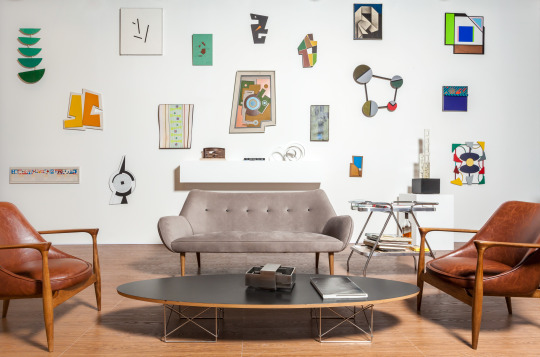
Leon Tovar Gallery at Bogotá International Art Fair, 2016. Photo by Mateo Saenz.
-------------------------------------------------------------------------------------------
In this past year, a lot of the ways in which art dealers do business has changed. Can you talk about some of the changes you’ve seen, whether positive or negative?
I could spend two hours answering that question. I think today, the most important shift as a result of the current need for digital outreach is that galleries have started to be important again.
Important galleries – no matter their size – will survive, and prevail, because now collectors, more than before, need to have confidence in their dealers. They cannot go to art fairs, and they need to trust in the expertise of the gallery. If people want to buy Latin American art, they would prefer in this case to buy it from us, or from a serious dealer from Latin America, rather than to try to buy things online from someone they don’t know.
Digital tools give us an advantage but can also work against us. At the end of the day, you don’t always have control over the information that’s put out into the digital world. It’s a very risky moment right now in terms of information, and misinformation, too.
But in the pandemic, if you use these tools with level-headedness and with discretion, like we do at the gallery, it’s an advantage. They help a lot. You can do digital exhibitions. But at the end of the movie, galleries will be there forever. I think we are, in our case, using our platforms very responsibly. We don’t want to be aggressive with people because they are fatigued with digital platforms. You need to manage that.
I think you make a compelling and resonant point – while the digital platforms provide access, nothing can replace the value of humanity and personal relationships. And it is the relationships that will ultimately survive this process.
Exactly—it’s the sharing of knowledge. Knowledge is not Google. Dealers need to build experience, to spend the hours, spend your life, your money, your energy, probably your own private life. As a dealer you need to educate yourself, as much as an art historian. When you do this, you dignify the whole ecosystem, with collectors supporting galleries, galleries supporting artists, and artists supporting museums.
You can’t do everything online – that’s why museums postponed exhibitions. It doesn’t make sense to spend millions of dollars to do an online Francis Bacon retrospective. You need to bring people to the museum so they can see why Bacon is Bacon.
We will be back in person eventually, and will also continue making use of digital platforms. But we, at the gallery, will go back to our roots because a year ago we were so crazy and in such a rush. The fairs, the exhibitions, and also the preparation of these events – it’s a huge responsibility, a huge undertaking. Even though we are a small gallery we have a big operation.
Now we’re calmly developing our program. We’ve deaccelerated our process. We are going slower, but we are more precise and focused. You learn to be more selective with your time, and think seriously about what you want to do in the future. The collectors will come to you. If you have good work, they will come.

Leon Tovar greeting the King and Queen of Spain at ARCOmadrid, 2015.
-------------------------------------------------------------------------------------------
In the course of these conversations, themes develop organically. Responsiveness and shifting goals to meet your situation seems to be a theme for you.
It’s a combination of opportunity and resourcefulness – together, this makes you lucky.
We take opportunities. We’re competitive, we’re active, and we know what we’re doing.
100 years from now, 200 years from now, what do you hope will be the legacy of your gallery?
I’d like to think that a crazy, small gallery from Colombia started a project that eventually was developed for universities, for education, for the future. I think that Latin America, as a vast region, has suffered a lot. The artists from these countries make incredible efforts to manifest their own feelings and ideas, and are as important as any other artist in the world.
I think the most important thing is that people realize that knowledge is the key part of our program. We are here – humbly – to educate people about Latin America and the connections that exist between our artists and the rest of the world.
-------------------------------------------------------------------------------------------
All images courtesy Leon Tovar Gallery, New York.
2 notes
·
View notes
Text
"I Like to Put People and Art Together" – Wendi Norris on Connecting with a Wider Audience
by Kim Cabrera • December, 2020

Wendi Norris, photo by Marc Olivier Le Blanc.
-------------------------------------------------------------------------------------------
In the early 2000s, having spent more than a decade working in tech and business, Wendi Norris was feeling burned out and professionally unfulfilled. She began to think about what was missing in her work and why it was leaving her so unsatisfied. “I noticed that the people around me who were doing what they loved were also the ones who were the most successful,” Norris told us.
That realization would lead to the opening of Gallery Wendi Norris, headquartered in San Francisco. Working at first with a business partner, Norris took full control of the gallery around 2011, which allowed her to pursue her own, very specific curatorial vision. The gallery is often associated with the work of Latin American Surrealists, including Leonora Carrington and Remedios Varo. The roster, however, is wide-ranging, incorporating modern artists such as Dorothea Tanning, Wolfgang Paalen, and Alice Rahon with contemporary artists such as Chitra Ganesh, Ana Teresa Fernández, Peter Young, and Ambreen Butt.
Gallery Wendi Norris has a unique business model that is rooted in flexibility and focused on building relationships. Central to the gallery’s vision is a commitment to site-specific, multi-city exhibitions, allowing Norris and her team to travel to wherever they feel will best serve their artists and facilitate connections with collectors, critics, curators, and the public on a larger scale.
We chatted with Wendi about her decision to become an art dealer, her flexible gallery model, and how passion, scholarship, and solid business sense work together to form the gallery’s foundation.
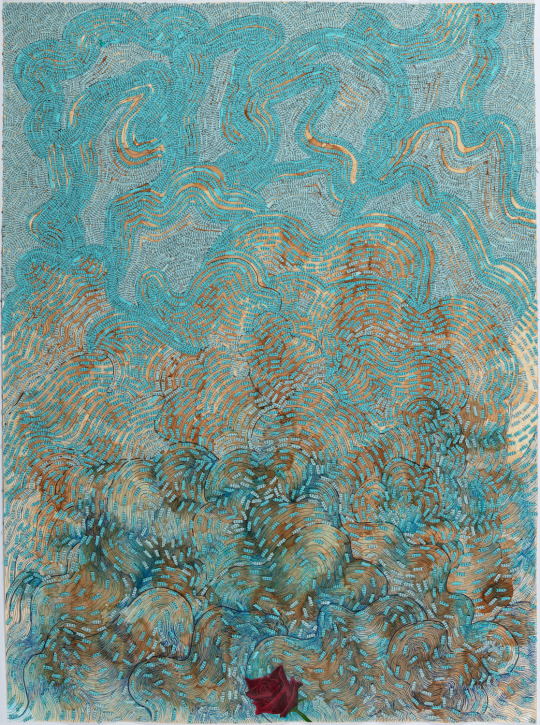
Ambreen Butt, Mohammad Yaas Khan (16), 2019, text, watercolor with white gouache, and pen on tea-stained paper.
-------------------------------------------------------------------------------------------
When did you first become interested in visual arts?
For me, there was definitely an “aha!” moment. I was a junior in college on a study abroad program in Madrid. At the time, my academic interests lay in economics and Spanish. I was allowed to take one elective during the semester, and I somewhat randomly chose art history.
At the end of the first class, my professor said, “We're going to meet on Tuesday at the Prado before it opens.” I had no idea what he was referring to, and I actually raised my hand and asked him what the Prado was. Anyway, I remember being at the museum; I remember being drawn into the fantastic and terrifying world of Goya. But mostly I remember entering a dark gallery, approaching a canvas, and finding myself in front of Velázquez's Las Meninas. I was mesmerized. I had goosebumps. I couldn’t tear myself away from it. I had never seen anything like that. That was the moment, for me, at which an entirely new world opened.
You have this moment at the Prado and you realized that art resonated with you. But you were actually in the tech world for 10 years before you shifted into the gallery world, is that right?
I worked for at least ten years in tech and business before making the shift. During that time, I was primarily working overseas. The first two things I always did upon arrival in a new city were to visit the local market and to find my way to the museums. It's still the way I travel. You can get a very good education in art and culture at markets and museums.
Before I moved to San Francisco in 1999, I lived above an art gallery in Paris. I got to know the owner and a few of his artists really well, and I bought my first piece of art from him.
So, you're back in San Francisco, you've made the choice to leave tech and to open the gallery—what were your initial ideas about what the gallery would be?
I began according to my training and education in business; I wrote a business plan. I still have that plan, tucked away in a private file. My early ambitions were moderate—I just knew that I wanted to be in the art world. But those ambitions started to take shape as I wrote my plan. My early vision was mostly values-based. It was not about wanting to have multiple galleries around the world and sell work at such-and-such a price point. It was more along the lines of, “I want to work with great artists.” It still is. I was also interested in connecting as many people as possible to art by presenting important exhibitions and educating people throughout the process.
In the midst of writing the plan, I organized an exhibition for two of my closest friends who are artists. I invited friends and business colleagues and I sold every single piece. That was really a catalyst for me to say, “OK, I'm doing this.” It was proof that I could do it.
Is that ability to sell a skill set from your previous career? Or is that something, because you're passionate about the work, that came naturally?
In my previous work I was often opening markets for products or investments by launching tech or connecting companies and investors to new global market opportunities. In the art world, I would say I'm a matchmaker; I like to put people and art together. I have strong convictions about my artists, so there’s that. Many of the best dealers that I’ve watched and learned from are first of all just enthusiastic about the work. People respond to that. Great art sells itself. But one also needs to be a good listener. I try to understand what people are thinking and what the obstacles to buying might be for them. I'm not ever really consciously selling, but I am consciously connecting people with art I believe they should consider.

María Magdalena Campos-Pons, El Mensajero, 2011, composition of 12 Polaroid Polacolor Pro 24 x 20 photographs.
-------------------------------------------------------------------------------------------
How do you pick the artists that you're going to show in the program?
I have criteria, but for me it’s ultimately a gut check. I might begin by wondering if there is something I can do for this artist. Can I have a great impact on this artist's career? Their legacy? Is there a story that has not yet been told that needs to be told? Then (and only then), I ask myself if there is a market for this work. Is there a “why this piece, and why now” aspect to it? But first and foremost, the work has to grip me, in the gut. I'm always looking for the “goosebump” effect I had when I was standing in front of the Velázquez. I don't get it every time I go on a studio visit. But when I do, I pay attention.
For my contemporary artists, I have to respect their vision and their work ethic and their code of conduct. I don't need to be their best friend, and I don’t judge—but the relationship ends up being very intimate and personal. I communicate with at least one of my artists almost every day.
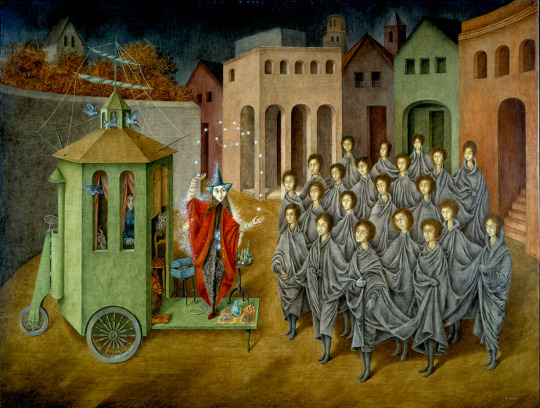
Remedios Varo, El malabarista o El juglar, 1956, oil and inlaid mother of pearl on masonite.
-------------------------------------------------------------------------------------------
You're seen as a real champion of Latin American Surrealism. Can you talk a little bit about how that came to be?
My interest in Latin American Surrealism dates back to my previous business partner. He worked on the Leonor Fini estate in Paris in the late ’90s, and he basically brought Fini's work out here to the West Coast. At the time, nobody was really paying attention to her.
And then two things happened. First, Whitney Chadwick, the pioneering scholar who authored Women Artists and the Surrealist Movement, among other seminal books, became a friend to me and a guide of sorts. We met regularly and those long lunches and coffees were immensely formative.
Second, I went to Mexico City shortly after opening the gallery, at Whitney and Susan Aberth’s encouragement. One of the first people I met there was Leonora Carrington. I got to know her well and visited with her over several years, and we did an exhibition together. Leonora had a great influence on me. She and I had lots of discussions, particularly about Wolfgang Paalen, a modern artist now on my roster. His writings and teachings have almost a cult-like following. He really provided me with the conceptual foundation for my program and the foundation that I rely upon even today in the contemporary world. And through Carrington I got to know Paalen’s philosophies because she knew him really well. Everything kind of came from that.

Installation view, Wolfgang Paalen and Abstract Spiritualism, Frieze Masters, Regents Park, Gloucester Green, London, October 6 - 9, 2016, photo by Charlie Littlewood.
-------------------------------------------------------------------------------------------
You had the incredible Carrington show here in New York in 2019, on the Upper East Side.
Yes. That was a lot of effort. I've been working with Carrington’s material for nearly 18 years. I'm involved with the collectors and with the scholars writing and publishing books on her work. And if a museum is looking for something, they'll typically come to my gallery to find it.
That show in New York is a great example of your gallery model. You do site-specific shows in many different cities, not just in San Francisco. Can you talk about the choice to go from a more traditional gallery model to something that's more nimble and responsive?
The process was a fun business challenge for me, given the various changes in the art industry over the past 20 years. I gave myself a lot of time and space to come up with a business model that I felt would work best for me and that could also be adopted by others.
If I had done my 2019 Leonora Carrington show in San Francisco (my third solo show for the artist), what would I have accomplished for Carrington and for the gallery? I don't want to have more real estate, more overhead. But when I revisited my values, the essence of the gallery, I kept thinking about accessibility—my mission to connect people with those artists that I champion.
This offsite gallery model was also born out of working with a culturally rich, internationally diverse roster of artists for the past two decades. How do we echo the global nature of the program without taking on permanent real estate? My team and I also have curated and produced some complex public projects. So I knew that we could problem solve and adapt.

Installation view, Leonora Carrington: The Story of the Last Egg, Gallery Wendi Norris Offsite, 926 Madison Avenue, New York, NY, May 23 - June 29, 2019, photo by Dan Bradica.
-------------------------------------------------------------------------------------------
Art fairs factored briefly in my decision, because fairs have become such a dominant part of the industry, pre-COVID anyway. I always entered an art fair with such excitement and zest and confidence that everything was going to find a home at the end of it. But the fairs always felt short-lived. I always wanted to spend more time with the collectors.
As an example, one of my contemporary artists—Ana Teresa Fernández—is based here in San Francisco and we did a show for her in Miami because I have great collector and institutional relationships there. My team and I were there for six weeks. We were able to build more meaningful relationships with collectors during that period than we had during the fairs themselves.
For the Carrington show in New York, collectors and curators knew who we were, but they also had an opportunity to visit us regularly. We had Roberta Smith and Jerry Saltz in the gallery for hours in total, and it was amazing! I never would have had that kind of experience with them otherwise.
It's about taking that art fair experience, the connections one makes there, and just settling in. I'm a little old-school, and I like developing those relationships because I think it's easier to have one client who supports you across the program than to try to get twenty who periodically support you.
I think the key word there is “relationships.” The gallery is really built on this idea of relationships with the artists, with the clients. Do you put yourself in their cities and their hometowns as a way to open the door for that opportunity?
Yes, a great deal of the success I have enjoyed comes down to that. Even if you're using the digital realm to help you to sell art, and even though that realm is important, it does come down at the end of the day to a relationship. People need to trust your vision. If they acquire a couple of artists from your program, and they're thinking about adding something more to their collection, you want to be one of the people they reach out to when they ask, “Hey, what should I be looking at next?” My team and I have helped to build some fantastic collections over the years. That's because collectors trust us. They come back to us and they refer their friends to us. The relationships that I'm trying to build are long-term.
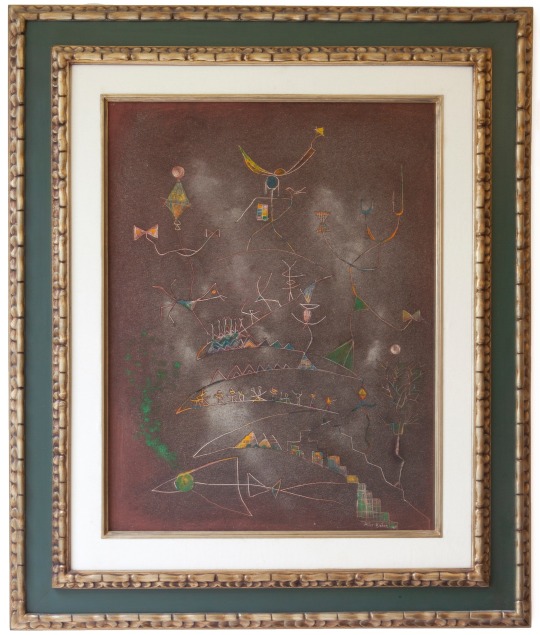
Alice Rahon, Autorretrato con autobiografía (Self-Portrait with Autobiography), 1948, oil and sand on canvas.
-------------------------------------------------------------------------------------------
Do you think that shift to digital is one of the biggest changes that's occurred in the last decade?
One of the biggest changes over the last decade is the speed at which people are being asked to do things. The digital realm has created great global reach but it also creates a race for more likes, more emails, extended digital presentations, or multiple virtual viewing rooms. This digital churn is similar to the art fair churn in that it takes up exponentially more time now than it did ten years ago. That leaves less time for artists, collectors, critical thinking, and better decision making. I would prefer to share that energy with collectors, whether I'm meeting them personally, on the phone, sending thoughtful emails, or on a Zoom call like this. I see an art world that is going very fast in one direction without stopping to slow down and think about the direction in which it’s traveling until it’s forced to do so.
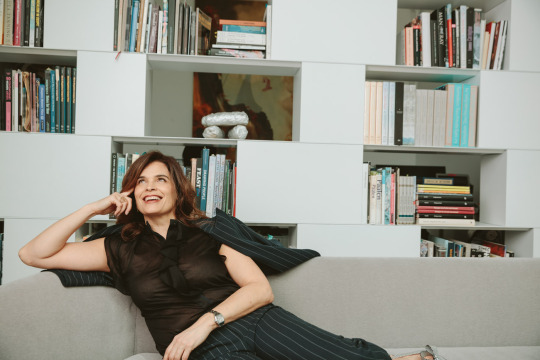
Wendi Norris, photo by Marc Olivier Le Blanc.
-------------------------------------------------------------------------------------------
You and your team have done some beautiful publications. Is that something that has always been important to you from the get-go?
I have a book problem. I have a lot of books. But that’s because I believe in cultural and visual literacy. I believe in education. I come from a family of teachers and professors. Writers and critical thinkers contribute a great deal to our industry, and yet they seem to be the most adversely affected right now. They need support, and they deserve it. Ultimately, the books are for the artists and their admirers, and they serve as a permanent documentation of the work.
Do you have any advice for people just starting out as collectors? Like that moment when you bought your first work from the gallery in Paris?
I tell new collectors, the ones I'm just starting out with, “buy what you love; buy what you can pay for; buy what you can afford.” I may not have that first painting I bought permanently installed in my home, but I think of it with great fondness. One’s eye changes and evolves. I think figuring out what you love in art and making sure that you have some goals in terms of what you want to spend makes collecting a little easier—especially with couples that collect.
Ultimately, I think your vision will serve itself. I never advise people to buy for investment purposes, even though art can often be a great investment. If someone's coming into the art world based on following a trend or for an investment, I think they’re following the wrong path.
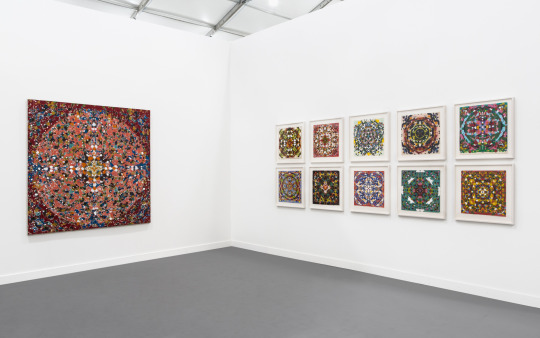
Installation view, Peter Young: Mandala Paintings (1973-74), Frieze New York Spotlight, Randall’s Island Park, New York, NY, May 4-7, 2017, photo by Dawn Blackman.
-------------------------------------------------------------------------------------------
Do you have any advice for young, aspiring art dealers who want to get into the business?
Take your time; work in and around a gallery; do your research. But most importantly, establish a set of values that are important to you and the way you want to run your business. That should go for almost any entrepreneur. Core principles are essential. They are what will set you apart from others and sustain you in the long run.
In the wider world, the one we share, I believe that galleries need to develop a better way of working together. The system should flourish at all levels instead of the same few mega-galleries gobbling up the artists once the small or mid-sized galleries have invested in building their markets. Without a diverse array of galleries, both in terms of geography and size, we will kill the very nature of the business, the ability to discover and nurture artists. I want to enhance the competitive structure by creating more galleries, not more massive, monopolistic-behaving ones.
Would you recommend making a business plan?
Yes, absolutely. The act of writing something down—whether it's a Venn diagram or a bar chart or a set of goals articulating a vision—it’s an essential part of the process. Writing is not recording. It is a fundamentally creative act. It also provides you with the opportunity to ask yourself a series of important questions, not the least of which should be financial in nature. The process of planning, on paper and with words, is crucial to any business. It is especially crucial to a gallery, because you need to understand what it is that's driving you and how you can be successful.
-------------------------------------------------------------------------------------------
All images courtesy Gallery Wendi Norris, San Francisco.
6 notes
·
View notes
Text
“I Always Considered Myself an Educator” - Eva-Maria Worthington on the Necessity of Scholarship in the Gallery
By Kim Cabrera and Ellen Dean • November, 2020

Eva-Maria Worthington.
——————————————————————————————-
With a deep interest in and commitment to art history, German-born Eva-Maria Worthington opened Worthington Gallery in 1970 in the suburbs of Chicago before later moving to the heart of the city’s arts district. One of the premier art dealers and historians specializing in German Expressionism, Worthington has worked with collectors and institutions, developing exhibitions around the country and internationally for artists such as Max Beckmann, Wassily Kandinsky, Käthe Kollwitz, Otto Dix, and other major Expressionists. In the 1990s, Worthington risked her reputation by playing an integral role in exposing art forgers who were exhibiting works in community colleges around the country, hoping to promote the work enough to later make millions off their reproductions.
This fearless nature has been apparent throughout Worthington’s career as she followed her passions and interests first, always believing in collecting what she loved and what she hoped to educate the public to love as well.
We had the pleasure of speaking with the Chicago-based gallerist to discuss how she came to open a gallery in 1970, the ways in which the Chicago art scene has changed over the years, and the important connection between art history and collecting.

Wilhelm Lehmbruck, Geneigter Frauenkopf (Nodding Women's Head), 1912-14, terracotta.
——————————————————————————————-
When did you first become interested in the visual arts?
My father wanted to be a painter. But his father died in the flu epidemic in 1919 and there was no money, so he became a businessman. He was successful, but then the war came and we lost everything. We lived in Kassel, Germany. Kassel is known to have the most Rembrandts outside Holland. There is a beautiful Old Masters gallery and a wallpaper museum. Kassel is also the town of documenta. There was a time after the Second World War where Germans could see the new art that had blossomed since 1939. I was exposed to art early on and of course we had art history and music in school. So that's where it all comes from.
What was your first official job in the art world?
I had started to collect all kinds of media. I was at home in Chicago, and I had an art background. I'd studied art history in Frankfurt and Paris.
Anyway, I got bored and so I decided I should open a gallery. I opened it in Winnetka, a suburb of Chicago, close to my home. When I founded the gallery in 1970, my husband, an attorney, immediately incorporated me because he was afraid I would lose the house. The gallery business is considered very risky.
How did you come to live in Chicago from Europe?
I was studying in Paris and I met my husband at the Sorbonne. When he went back to America, I went as well. We were married in Paris.
When you got to Chicago you studied literature at the University of Chicago?
Russian literature. Because I liked the professor with whom I had studied comparative literature. I loved to read, and he was a specialist in Dostoevsky and Tolstoy. I didn't take these things very seriously, I didn't want a degree.
1970 is when you became incorporated as a gallery. Did you move downtown at the same time, or a little bit later?
I spent a year in the suburbs, and all my friends came to the gallery, to chat only! It wasn't the place for me, so I decided I would go downtown. I rented the space next to the Museum of Contemporary Art on Ontario Street. Later I moved the gallery to Michigan Avenue when a big space opened up next to Richard Gray Gallery. It was in the same building where several galleries were, just on the corner of Michigan and Ontario. It had huge windows where I could display photos of my artists.
In those early days, did you have a formal exhibition program? Were there any particular favorites?
Yes, we had formal exhibitions. I exhibited all the German Expressionists and also the people who are not considered completely Expressionist: Paul Klee, Kandinsky, Kollwitz (whom I'm very fond of), Max Beckmann, Otto Dix, and so on and so forth. Every six weeks, a different exhibit. I published many catalogues. We had a very vibrant art scene at that time in Chicago.

Max Beckmann, Der Nach Hause Weg- Selbstbildnis (The Way Home), Plate 2 From the Series: Die Hölle, lithograph, 1919.
——————————————————————————————-
You are synonymous with expertise in German Expressionism, one of the go-to experts in that field. Was it because of your heritage that you became so emotionally attached to that genre of work, or is there another reason?
At first I was very interested in the Primitives, pre-Renaissance work. That led, somehow, to the Expressionists. I liked the colors and, of course, I speak German. To deal in German Expressionism, particularly in the works on paper, you have to know German. And I always liked it and I started collecting it, too.
You mentioned that the art scene in Chicago was very vibrant at the time. What made it special?
There were so many galleries right on Ontario Street, along with the Museum of Contemporary Art. Much of this has faded away now. The Arts Club was close to my gallery; I could just go out the back door to the Arts Club (of which I was a member). There were good galleries and people who knew what they were doing.
Do you feel there was a sense of camaraderie or community amongst the dealers at that time?
Well, you can't call it camaraderie, because they are all competitors. But, I don't mind that.
What do you think the biggest changes have been to the Chicago art scene and the art scene throughout the U.S.?
Fewer people are coming into the galleries and there is no art education in schools anymore. Students that have come up through the school system don't have any knowledge about art. It used to be that everyone went to the openings. Now people don’t attend openings as much; it's not the same thing anymore. It is similar in Europe—culture has taken a back seat to technology.
When you were first working with the German Expressionist material, did you find that it was hard for U.S. collectors to understand it?
You can’t say that people got on board very quickly. However, for instance, remember that commercial "Where's the Beef?" The man that made that commercial became one of my big collectors. Because he was interested in faces and the German Expressionists had faces. Not just landscapes or seascapes. It's faces! That's where the term “expressionist” comes from, I think. And, of course, collectors came to the gallery and talked to me. They also educated themselves. It's not the person who walks in off the street that will buy a German Expressionist artwork. You have to have a certain knowledge already, and a curiosity, an interest, that is not just always in everybody. They are usually people who know something about history, which of course is paramount in German Expressionism.
Collectors typically have an interest in history. Expressionism came to America through the immigrants. The majority of course were Jewish and they were the ones that brought that culture over here. And of course Dr. Valentiner was the big man in art history for German Expressionists. He came over before the first World War, later on he went back, but when the Nazis came, he returned to the U.S. and brought the German Expressionists with him. I always admired him because not many people liked German Expressionism in 1941 or '42. And of course in Chicago we had Dr. Joachim, the world famous curator at the Art Institute.

Eva-Maria Worthington at a gallery opening, c. 1995.
——————————————————————————————-
Would you consider yourself a dealer first or an art historian first?
Well, it's together. Because I also built up a collection and you never, ever should have your own collection in the field you deal in. That is wrong, supposedly. But I did it anyway because I didn't know any better.
I always considered myself an educator. Because that's what good dealers did. Because they sat there, in their galleries, and people could come and talk and never leave the whole afternoon, didn't buy anything but they were talking to each other. Even some of the big collectors did that. But they don't do that anymore. Now the internet is involved. I always say, “how would anybody buy anything from the internet?” In Expressionism you have to know the paper, etc., also different states, and media. It's complicated.
Would you tell us about your involvement in exposing the art forgery ring?
It is an interesting story—they always wanted to make a movie about it. It was 1993. A group of international forgers were situated in Ireland and England and they had a traveling German Expressionism art show.
I got a phone call from a community college museum one day. They told me they were offered, free of charge, an exhibit of German paintings, watercolors, and prints. I said, “Who's in it?,” and they rattled off all the famous names: Paul Klee, Kandinsky... “Free of charge?” I said, “No. Somebody is pulling your leg.”
The next thing I know, I get an envelope with a catalogue in it—it was the exhibit they were talking about, and it was right here in a suburb of Chicago. Everything was fake, everything in it. I read the story which was just too funny to be true. It had already been to 22 different community colleges. I said, “What am I going to do? These are all fakes, and they’re up there and the students are looking at the fakes!” Terrible, terrible. So I tried and called our association lawyer and he said to me: “Don't touch it. You'll get sued.” Well, I am not a coward.
I finally remembered I had a client, Allan Henry. He was a journalist. I called him and I said, “Henry, we have to shut them down.” He went with me to that college in Lake County and everything was a forgery, it was so bad. It was shut down.
In 1998, I got a call from the Sunday Times in London. They said, “Mrs. Worthington, you are the one who tracked down those forgers—we're writing a big exposé and know the forger.”
They convinced me to tell them my story. Anyway, in the Sunday Times the whole story was published and the fakers exposed. But, unfortunately, some people lost a lot of money to the fakers.
Would you say that Chicago has a distinct arts and culture community separate from what you might experience in New York or LA? Are there parts of the art world that you think are uniquely successful in Chicago?
We had something called the “Hairy Who,” amongst others. Their work has been very collectible for some time. Some of those artists liked German Expressionism; Jim Nutt and Gladys Nilsson, etc. They came to my gallery and looked at my exhibits and talked to me and so on.
Artists came to the gallery. They were very, very much interested in what other artists did, which had nothing to do with themselves but they were interested in it, they were curious.
Do you have any advice for aspiring art dealers?
It will be difficult but it's always good, when you start out if you have the Rolodex from people from your temple, your club, or whatever. You cannot start out cold, like I did, today. Of course, I must say, I had some private money, not much, but it was essential. I was always independent. And I bought my art. I put my money where my mouth was. I had a very loyal group of collectors. As a young dealer, you have to have that and you have to work hard, and you also have to write about art.
I would say you need to be a scholar to sell art. Some people don't agree, they think the main thing is sell, sell, sell. No. I don't think a really good gallery can do that without being art historically inclined. I love to read, you should see my library! I love the background of all the art, and I love the artists. For instance, Beckmann—I know Beckmann. To me, it’s like I know him personally. That's why I put together these exhibitions, making catalogues and so on, because I am really very close to him. And Käthe Kollwitz, same thing there. I have published quite a few catalogues.

Eva-Maria Worthington and her daughter Claudia Hess.
——————————————————————————————-
Do you have any advice for people who are just starting to collect?
Buy what you like. If you spend some money, serious money, find out the background. Buy from reputable galleries. If you think, “this is a really good deal,” it usually is too good to be true. That's what people do, they get carried away when money is so important. I never bought anything just to sell. I bought what I liked! I bought crazy things and thought I never could sell it, but I did. I always found people who liked what I liked. Of course, I still have a lot of art. My daughter's going crazy; she's going to inherit everything and says, “What am I going to do! It will take me years to go through it!”
Is there anything you want to talk about that we haven't covered yet?
I'm 51 years in business. And that is something. One person, no partnership, 51 years in the art business. And having done important exhibitions and traveling art shows in museums internationally, that is very unique. I like to make a little fun at times, too, because I think that life can be difficult for most people. Life is great and good. But, have a little levity. That's what I believe.
All images courtesy Worthington Gallery, Chicago.
5 notes
·
View notes
Text
“Collaboration is Critical to Our Gallery’s Character” - Maggie Kayne and Bill Griffin on the Origins and Evolution of Kayne Griffin Corcoran
By Sarah Evers • September, 2019
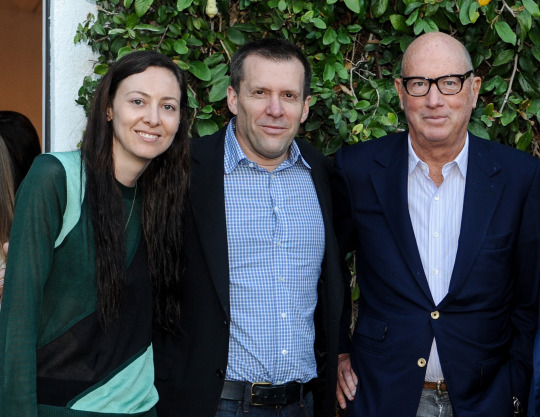
Maggie Kayne, Bill Griffin, James Corcoran. Photo by Stefanie Keenan.
Kayne Griffin Corcoran, a serene refuge off of a busy Los Angeles street, was originally conceived through a meeting of Maggie Kayne, Bill Griffin, and Jim Corcoran to discuss an artist commission and has since emerged as a destination in Los Angeles’s gallery network. Each offering a distinct perspective, the partners of Kayne Griffin Corcoran benefit from each other’s varied experiences, using their differences to foster innovation and constant evolution. A shared commitment to Los Angeles culture and history unites the three partners and acts as the framework from which they have built their roster of internationally-lauded artists and rigorous exhibition programming.
Bill Griffin had previously represented the likes of Southern California icons James Turrell and David Lynch and provides crucial insight on the strategic direction of the business. Jim Corcoran’s long career and extensive art historical knowledge helps to connect the thematic dots between established and contemporary artists. Maggie Kayne approached the art world first as a patron, turning her sights on galleries as a result of the potential of a partnership with Jim and Bill.
We spoke to Maggie and Bill about the partnership’s origins, the character of Los Angeles, and the importance of developing a unique creative vision.

Installation view of “Noboru Takayama,” 2018. Photo by Flying Studio.
When did you become interested in the art world?
Griffin: For me, I was always interested in a visual display of ideas and in learning about ideas through looking at objects. The visual arts was something I gravitated toward as early as elementary school and continued through college. The first exhibition I attended was the King Tut show at the Metropolitan Museum of Art, circa 1978. My mother was a public-school teacher and she somehow got tickets to see the exhibition. I remember waiting in line with her and stepping into the first gallery, crossing that threshold into the Met, and, for me, the world was changed that day.
Kayne: When I moved to New York for college I became friendly with a number of collectors who really opened my eyes up to new ways of seeing and engaging with the art world. I remember discovering this amazing ecosystem of artists, dealers, and collectors, and seeing opportunities to participate in and contribute to this network, not just be a passive observer. From that point on, I realized this was the world I wanted to be in. But it took me some time to find my home in it. I interned at museums, worked at a couple of galleries, spent time with various dealers, and learned all the hard lessons pretty quickly.
How did your careers as art dealers begin, and how does your history compare to where you stand now?
Griffin: In 1994, I borrowed a friend’s pick-up truck, drove to Home Depot, bought some drywall, and rented an old boat warehouse down in Costa Mesa. Twenty-five years later, here I am. I didn’t work for anybody and learned on my own. Working with Jim now for almost two decades has been a huge privilege and has been an incredible way to evolve my eye. Same with a younger partner like Maggie, who is to me incredibly inspiring and authentic in her relationship to art and the art object. I love to be exposed to new things, so every day since that Home Depot visit everything has continued to evolve with breakneck speed and has shaped my involvement in the art world.
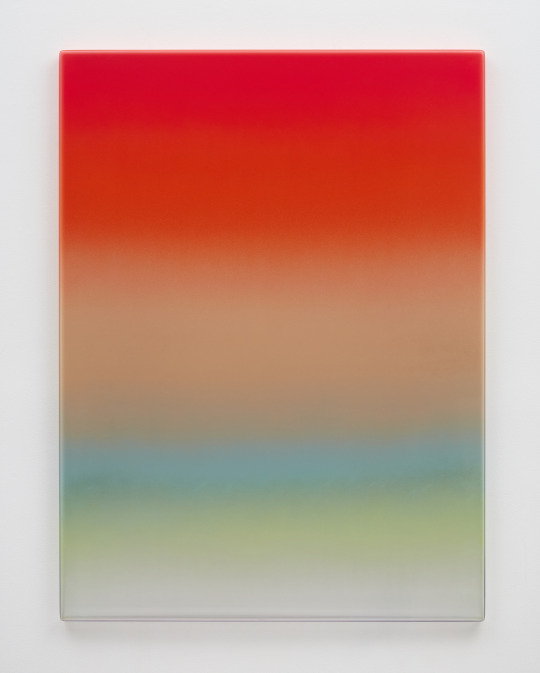
Mika Tajima, Art d'Ameublement (Nukutoa), 2019, spray enamel, thermoformed acrylic. Photo by Flying Studio.
Kayne: As mentioned earlier, I actually started off as a collector which was a really interesting departure point. The idea of opening a gallery didn’t occur to me until much later. In the beginning I just wanted to be around artists and absorb as much as I could. In addition to collecting, I would pick up odd projects here and there. The last thing I was doing before I met Bill was working with Hans Ulrich Obrist producing and filming interviews he conducted at the Venice Architecture Biennale in 2010. I also became very involved with several museums in a philanthropic capacity. I was a founding co-chair of the Hammer Museum’s Hammer Circle Group and a member of LACMA’s Director Circle. This dual identity as a patron/collector on the one hand, and as a dealer on the other, has been complex to navigate at times but has also provided me with a really unique vantage point to understand the diverse needs of artists, collectors, institutions, and many of the other players in the larger ecosystem.
What initiated the partnership amongst the two of you and Jim Corcoran?
Kayne: At this point, I had segued into advising and was working with two clients who were considering a James Turrell Skyspace. This led me to Bill and Jim who represented James here in L.A. I met with them and ended up having a three-hour conversation with Bill. Bill was doing really innovative things with his gallery, both operationally and programmatically, and I was really inspired by the meeting. He then called me two hours later and said “I want to offer you a job and this is what I think you can bring to the table, and this is what I think I can bring to you.” I started working for Bill in January of 2011 and by June we began to explore a more formal partnership. While working with Bill, I also got to know Jim quite well and knew his experience and reputation would be incredibly additive to the partnership. Bill said there was no way that Jim would be on board, but we called him to propose the idea and he said “Sure.” It was totally unplanned and, like anything, was also a function of good timing. Sometimes I laugh because it’s a bit of an odd match but the truth is the three of us have a great rapport, really complementary skill sets, and it just works!
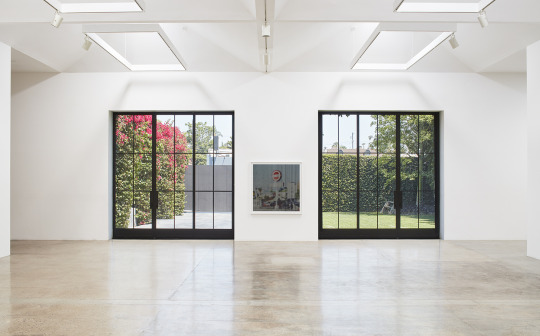
Installation view of “Anthony Hernandez: Screened Pictures,” 2019. Photo by Flying Studio.
Do each of you play specific roles at the gallery?
Griffin: The three of us just naturally respected each other and, like Maggie said, brought different things to the pot. As there is a generational difference of two decades that separate each of us, we have different perspectives on the culture that we live in and recognized this was strategically interesting. We believed in each other’s contributions and visions and just started working together. It has evolved into different things since then, Maggie is in a day-to-day capacity and is very interested in the creative studios and what’s happening out in the world. She’s very active in pursuing those ideas, working in collaborative developments with studios, curators, and other gallerists. I continue to work with a few specific studios, I handle some key client relationships and work on strategically evolving the vision. Jim, as Maggie said, brings his deep network of relationships, and pioneering knowledge of the Southern California art scene.
Kayne: I think if you were to divide it up, my role is definitely more creative. Bill is incredibly strategic and organized. He also appreciates the creative, but he is providing the structure that enables all of us to be successful and to implement our ideas in an effective way. Jim comes in with some crazy and brilliant ideas but also brings deep art historical and institutional knowledge to the table.
Griffin: It’s very unique and rare to find three people that genuinely, as Maggie said, are kind of odd and outliers in different ways, but still come together with a vision and have the ability to execute it.
Kayne: I think we’re also very aligned in our programmatic decisions in that we only work with artists we really believe in, even if the financial upside isn’t immediately apparent. We’re playing the long game and recognize that the market may take a little longer sometimes to verify an artist. We also really enjoy the cross-generational conversation that naturally occurs as a result of the twenty years between each of us.
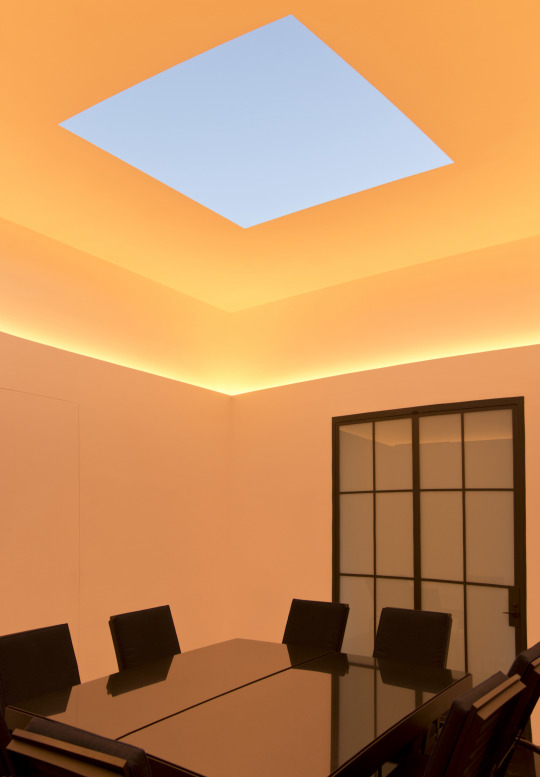
James Turrell, La Brea Sky, 2013, ©James Turrell. Photo by Flying Studio.
Is there a current through Kayne Griffin Corcoran that unites your three different perspectives?
Griffin: Jim came to Kayne Griffin Corcoran having worked with the studios of legendary artists including Ken Price, John McCracken, and Ed Ruscha, and this focus on the Southern California School is something that is still central to the gallery’s DNA.
Kayne: James Turrell is in many ways the cornerstone of the gallery. The three of us met through a Turrell commission and one of the first shows we did when we opened the gallery was an exhibition about Turrell’s project at the Roden Crater, called Sooner Than Later, Roden Crater. Through our experience selling James’s work, we realized when we got in this space that it would be a lot easier for us to sell holes in ceilings if we had one in our own! To have this Skyspace as the physical and spiritual center of the gallery is incredibly special and was also a game-changer for the business.
Griffin: We had long discussions with him about how to put a Skyspace into a working gallery and it came down to the fact that Skyspaces are places for people to meet and communicate, and that is what a conference room does in a business. Creating this Skyspace inspired James to look at the entire gallery space and address all aspects and we gave him free range to do that. The gallery is located on La Brea Avenue, this cement and tar highway packed with tens of thousands of cars every day racing by and then there’s our gallery, this kind of green oasis. That’s all James.
Kayne: He designed every detail and even mapped out the flow of the space. We brought him in even before the architect, because we knew that he had the ability, more than anyone else, to create a really thoughtful and considered experience. In fact, it was his idea to put a Skyspace in the conference room. He was most excited about creating a gallery space for his peers that had what he refers to as perfect flexible light. He says that he has shown in hundreds of spaces throughout the world and very rarely, if ever, does he see an exhibition space with perfect light.

Installation view of “Beverly Pepper: New Particles From The Sun,” 2019. Photo by Flying Studio.
How do you see the gallery in the larger landscape of the Los Angeles art scene?
Kayne: The vibe of our gallery, both in terms of the programming and the physical space is very much tied to the DNA of Los Angeles. We love this city and are really invested in the cultural community here. This is reflected in the artists we work with, the institutional relationships we cultivate, but also the gallery itself, and even the way the architecture was designed to embrace the particular geographical and cultural differences that make Los Angeles so unique. We’ve got this incredible light, the weather is unbelievable, and being outside is a huge part of the culture here. We’ve really capitalized on this with our courtyard, which we use all the time for outdoor programming and entertaining. I think we’ve also managed to create a really special and refreshing work culture at the gallery which has allowed to us to attract and build an incredibly talented group of professionals.
Griffin: I think our philosophy has developed through our time in L.A. and collaboration is critical to our gallery’s character. We believe in finding good partners globally outside the gallery and fostering productive, long term relationships. I think it helps many galleries know that we are singularly focused and grounded in Los Angeles. Our future is like the past, very organic and open. We know who we are and we look out towards the world but we are very satisfied in the City of Angels. That’s our history. It’s been Maggie’s growing up all her life, mine for the last two decades, Jim’s for his life. That threads through everything that we do and through all of our actions.

James Turrell, Medium Rectangle Glass, 2019, L.E.D. light, etched glass and shallow space. Photo by Flying Studio.
As a newer member to the ADAA, what made you want to join the Association?
Griffin: I think that the ADAA is important as a historical network, but also in the fact that we can all contribute and help it evolve. It makes us better, too. The ADAA’s services affect many elements of our business. I find it to be a wonderful organization to be a part of, and I mean that genuinely.
What significant changes have you seen to the gallery business over the past decade or so?
Griffin: My thought right off the bat is the speed of communication and the speed of how things take place. When I started, we had FedEx and fax machines, and all those things were fast relative to the generation before that. Today, the quickness, the ability to connect and communicate with peers globally, instantaneously and with incredible resources, is remarkable.
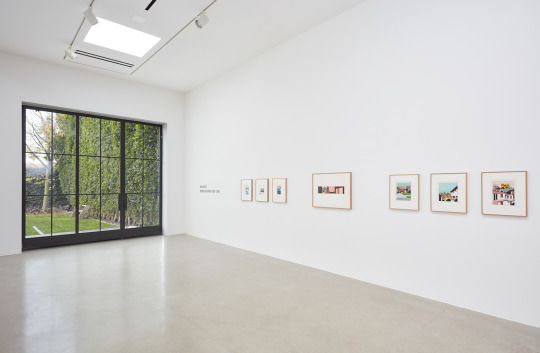
Installation view of “Ken Price: Works on Paper 1967-1995,” 2019. Photo by Flying Studio.
Do you have any advice for an aspiring art dealer?
Griffin: Speaking from a dealer’s standpoint, my advice would be don’t follow the market. Create a unique vision, support your artists, work hard, and success will follow.
Do you have any advice for a budding collector?
Kayne: The eye is a muscle and needs to be exercised–and not just online! Show up at gallery openings, visit museums, attend art fairs, and make an effort to see things in person. And buy with your eyes and your gut, not with your ears.
*All images courtesy the artists and Kayne Griffin Corcoran, Los Angeles.
1 note
·
View note
Text
“Focus on What’s Essential to You” - Franklin Parrasch on Making Your Own Way in the Art World
By Sarah Evers • June, 2019
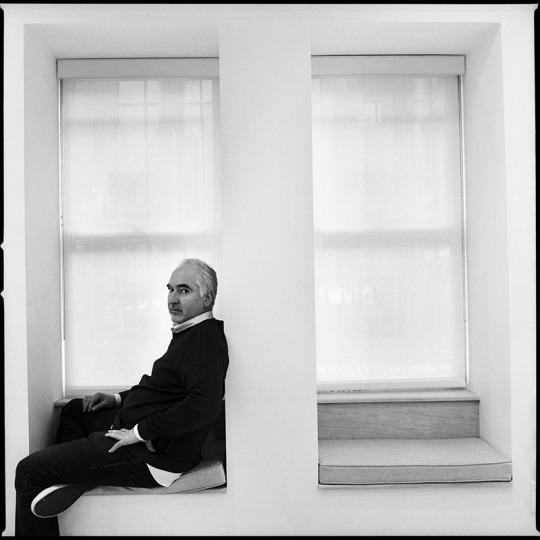
Photo by Jaiseok Kang. All images courtesy Franklin Parrasch Gallery, New York.
Walking through the Upper East Side of New York City, you may miss the unassuming façade of Franklin Parrasch Gallery. If you slow your pace to take in your surroundings and discover the gallery’s entrance, you will be rewarded by the highly cultivated exhibitions waiting inside. Located in a townhouse on 64th Street with a secluded back patio, Franklin Parrasch Gallery asks you to take the time to fully consider the work on view and how it contributes to ideas of evolution, perception, and migration.
Since his first gallery opened in the 1980s, Franklin Parrasch has maintained a dedication to furthering the careers of artists whose work defies any predetermined definitions of media or style and seeks to address existential questions through physical creation. Parrasch opened his first space in Washington, D.C. and found his passion for the intersection of art and craft, a passion that is still palpable in his curated shows in the New York City gallery. A commitment to supporting artists with distinct perspectives is fundamental to Parrasch’s role as an art dealer.
Working primarily with artists from Los Angeles while operating a business in New York City may seem an unconventional premise to some, but Parrasch makes compelling connections between the two cities through thoughtfully curated shows. In fact, Parrasch furthers this association through partnerships in both Los Angeles (Parrasch Heijnen Gallery, with Christopher Heijnen) and Beacon, New York (Parts & Labor Beacon, with Nicelle Beauchene). Whether dedicating solo exhibitions to artists he’s been representing since the 1990s or exploring hosting shows organized by galleries across the globe, Parrasch finds a way to fuse disparate ideas together in a seamless narrative.
We spoke to Parrasch to find out more about the origins of his gallery, his connections to Los Angeles, and the importance of community to his business.
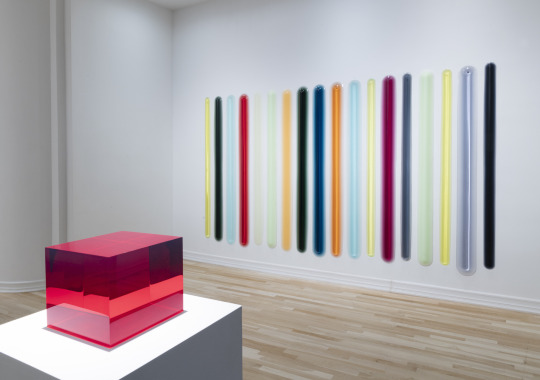
Installation view of “Peter Alexander: recent work,” 2018. Photo by Adam Reich.
What inspired you to pursue a career in visual art?
I was five years old, in kindergarten in New Jersey, and my friend’s mother, who was an artist, took us to the Museum of Modern Art one day. We walked into the atrium, which was quiet and completely empty. It was just the three of us, and there were two things on the walls. One side was Guernica by Pablo Picasso, and the other side was The Dance by Henri Matisse. And that was it. Guernica, in particular, left a permanent impression on me; I was intrigued by how he combined all that imagery spatially, and fed all that information in such an exciting body of space. And I went back and drew pictures, not what other kids would do I guess, but I kind of got obsessed with that one. The intensity of both of them stayed with me—Guernica, and the poetic grace of Matisse, they all figure into what I value in art.
After I finished my undergraduate degree at Hampshire College, I worked as a color printer for various photographers, some of whom were artists, and I also worked in photo labs. When I started the gallery in Washington, D.C., I took a night shift working at another lab. I also managed the school galleries at both Hampshire College and Rhode Island School of Design (RISD), but had no prior commercial gallery work experience.
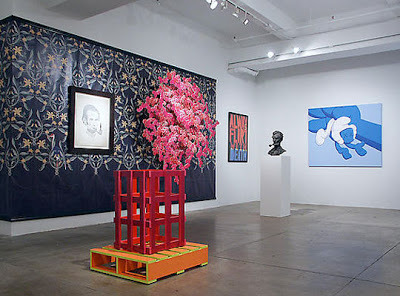
Installation view of “Everything Else,” 2008.
What led you to opening your original gallery space in Washington, D.C.?
I just happened to be there because my roommate in graduate school at RISD was from D.C., and there was a thriving art community going on in D.C. at the time. It was sort of the tail-end of the Reagan era and people were collecting. It was something to do if you had new money and there were some major collecting families in D.C. There were also some really great galleries at the time. Jack Shainman and Max Protetch both had spaces there. Martin Puryear was showing there, many artists of the Color School were working there, and it was a really active place for contemporary art. Also, of course, all the museums.
I came across an ad in the Washington Post for free gallery space in exchange for managing the building. The building of course turned out to be an hourly hotel, and I had no idea what that meant until I got there, but it worked out. I actually got a gallery running and got things to happen within that first year.
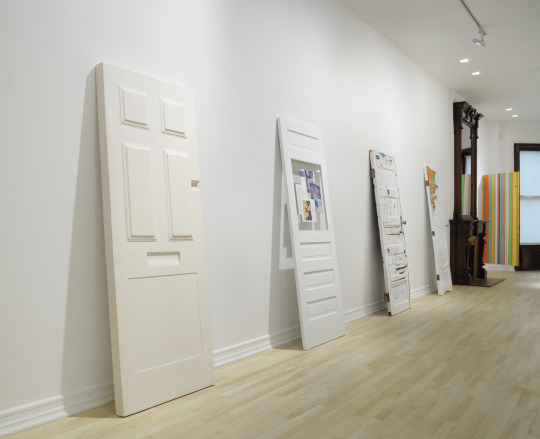
Installation view of “Please Enter, Curated by Beth Rudin DeWoody,” 2014. Photo by Katharine Overgaard.
What type of work did you show in the beginning?
While I was at RISD, I saw a graduate show of what appeared to me to be installation art. And what it was, in fact, was an installation of studio furniture by one artist. And I became fascinated by that, and I became much more fascinated in general with craft and the fine arts and how they integrate within the larger picture of contemporary art. And I decided I had to do something about that.
What inspired the move to New York?
I wanted to come back here and sort of get more connected with my roots in this area, and also to really up the ante and be involved in the arts scene here. I opened up a 4,000-square-foot space on lower Broadway in 1989 and held many memorable shows there, including our first career survey of Ken Price. The building had only galleries in it and they were relatively small, kind of a white-cube style.
The following space, on 57th Street, was where I first installed a kitchen and it became a tradition that has carried to this current space. I think it’s really important that people eat together and converse over a meal, and eat the same food and talk about it and feel on the same level. It keeps people together and closer.

Installation view of “John McCracken: red, black, blue | Painting and Sculpture, 1966-1971,” 2015. Photo by Kent Pell.
How do you see the communal meals as part of the gallery’s business model?
I’m sort of obsessed with cooking. I need to feed people, it’s something that’s sort of inherent in me. When people come to visit, I really like the fact that they enjoy the food they’re having and they enjoy sitting out at the table and talking about art and anything else that’s going on. And that affects how we socialize with our clients, and our friends, and our colleagues. It builds relationships. I would say that, for me, cooking is really integral to how we socialize.
Has your interest in craft stayed consistent through your different gallery spaces? How have you seen your interests change over time?
I’m still fascinated with the conversation of how aesthetic pleasure and efficiency tug at each other, and how there are coalesced moments. This is something that I think is inherent in everything we show. And even to the point of conceptual art, even when there’s no product at all, there’s still this element of how the mind perceives function that I’m very interested in. I also consider perception and find it to be the crux of art and evolution, which is a thread that weaves through each of our shows. Each exhibition typically has relationships to the processes of migration and evolution. Many are reckoning with the question: “Why are we here?”
I find that I’m drawn to artists from Los Angeles because the lines between craft and art there are more blurred than they are on the East Coast. I started meeting some people in L.A. and eventually realized I was very intrigued with Ken Price’s work, which I’d seen at a Whitney Biennial in the early ‘80s. I wrote him a fan letter and he invited me to come to his studio. When I got there, we just immediately connected. It was like we knew each other. We talked for an hour about his work, decided to go get lunch, and he just said to me, “I want you to be my dealer.” And I was 32 at the time. It was like a lighting bolt went off. Here I was, this kid, essentially, being asked to represent Ken Price. It was life-changing.
We of course show artists from other places—there are usually particular reasons for that—and they’re related to the thoughts and concerns we’re trying to focus on. But I find California to be this place people gravitated toward as an expression of where they could go to become themselves. And that’s what I’m intrigued by.
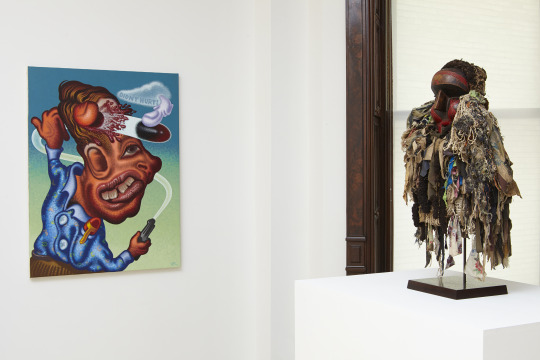
Installation view of “Peahead: Rita Ackermann, John Altoon, Cecily Brown, Chris Dorland, Jean Dubuffet, Jason Fox, Peter Saul, Joan Snyder, Michael Williams, and Chewa Mask,” 2014. Photo by Kent Pell.
How did this connection to Ken Price affect the gallery’s programming? Did you see any dramatic shifts?
Ken Price introduced me to his friends, who were a close-knit group of very gifted artists that included Larry Bell, Joe Goode, Ed Ruscha, Craig Kauffman, and Peter Alexander, all of whom I had an interest in and showed. This was in the early ‘90s, when things were a bit slower in the art world, and they had seen the successes that we had with Ken and they wanted to find out more about it. And that really helped direct where things evolved in the gallery. I began showing pretty steadily with Billy Al Bengston, Larry Bell, Joe Goode, and those relationships intensified. They also found other representation on the East Coast, and their careers blossomed. We did a lot to help get these Los Angeles artists established here.
But it wasn’t just Los Angeles, it was further south, like with Tony DeLap, and it was further north in the Bay Area, like with Robert Arneson. In late ‘92, soon after Arneson passed away, I visited his studio and asked his widow about a work I saw on the shelf. She told me it was a student of his, Kathy Butterly, so I sent her a note and we did a show with her soon after in 1993 and continued showing her work regularly.
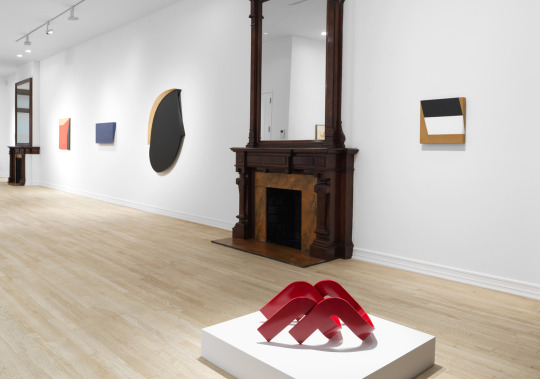
Installation view of “Tony DeLap: A Career Survey, 1963-2016,” 2017. Photo by Adam Reich.
There were a lot of other events that took place in those years. I showed the models and drawings of the architect James Wines. He was the founder of the architecture firm SITE, which did very challenging, almost artistic projects. One of his biggest clients was Best & Company, which was owned by a very interesting philanthropist and collector in Virginia, Sydney Lewis, who commissioned all these buildings with falling rocks, and cars in the parking lot buried under several feet of asphalt. It looked like the building was blowing up in one case. These were really challenging buildings. I really loved the idea of function and aesthetic interests being melded. That’s kind of what I wanted to stay close to in all of this.
What differences do you find between the art worlds of New York and Los Angeles?
I think that New York has a much longer, more developed, and very tiered history, and the arts infrastructure of Los Angeles is more recently developed, and constantly changing and reinventing itself. What interests me about the art world in Los Angeles is that it’s not tied so much to any dogmatic point of view. It’s up for change, it’s up for a challenge, it’s up for morphing. I think that’s the big difference.
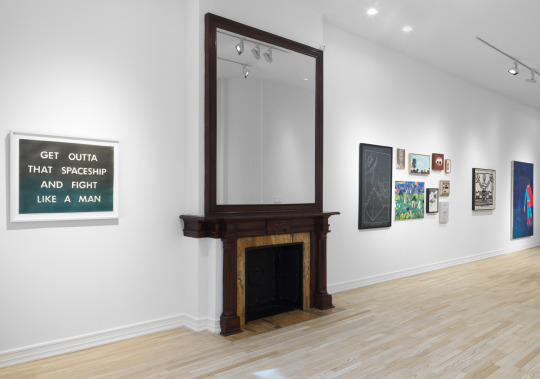
Installation view of “Get Outta That Spaceship and Fight Like a Man,” 2017. Photo by Adam Reich.
Can you tell us about the current show on view and what you have planned next at the gallery?
Joan Snyder, who we have represented for about six years, has often told me stories of coming out of the MFA program at Rutgers and finding this warehouse space with fellow program graduates Jackie Winsor and Keith Sonnier. I really got to thinking of what it’s like to be a 25-year-old out of graduate school and starting a practice and a studio on your own. Back then, it was so much harder because there weren’t facilities for this kind of thing. Yes, they got this building for a song, but it didn’t have electricity, it didn’t have running water and they had to pipe it in from elsewhere. But they did that. They were scrappy, youthful, and strong, and they all figured it out. And what ended up happening was they reinvented some of the basic languages of contemporary art in that space in their 20’s. It’s kind of amazing. You know, Keith did his first neons, and Joan did her first stroke paintings, and Jackie did her first rope sculptures in that building. And I felt that was just historically brilliant, and worthy of a show.
For our next show, we’re participating in Condo. Last year, we hosted Misako & Rosen from Tokyo and Gypsum Gallery in Cairo. This year, we’ll be hosting mother’s tankstation limited with locations in Dublin and London starting June 27, 2019. I’m looking forward to meeting them. We came up with an idea integrating Peter Alexander’s work, so that should be interesting.
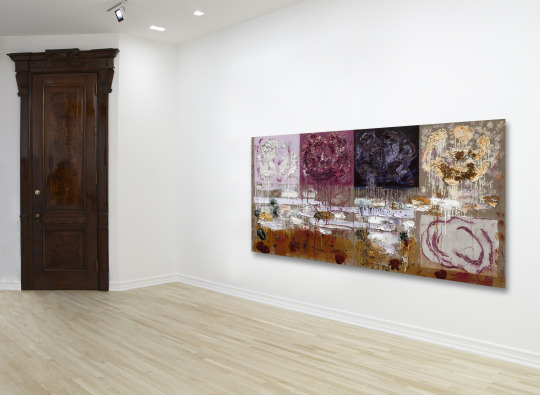
Installation view of “Joan Snyder: Sub Rosa,” 2014. Photo by Katharine Overgaard.
In addition to the emergence of Condo as a gallery-sharing initiative, have you seen any other major shifts in the gallery business over the past decade?
I think the decade hasn’t seen that drastic of a change from my perspective because I’m not that involved with technology or social media. I’m sure that’s a big change for most people in the art world, because there’s this vast influx of interaction on that platform, but it’s been pretty much very similar for me. I see some of the trends changing, and not changing, and there’s always going to be hype that motivates a certain thing within the art world.
Do you have any advice for someone aspiring to become an art dealer?
First of all, focus on what’s essential to you as somebody who looks at art. Don’t let it be about extraneous matters, social circumstances or anything like that. Focus on what’s essential to you about art itself. And make sure it’s so essential to you that it wakes you up in the morning. Because it’ll also keep you up at night.
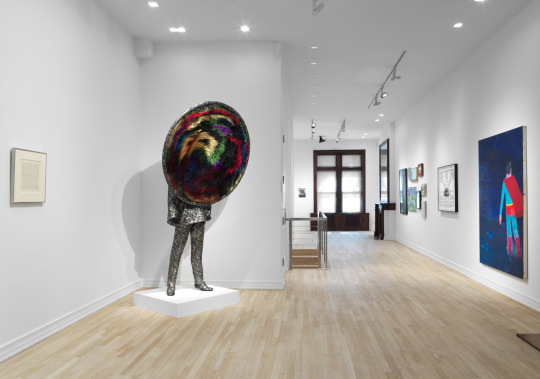
Installation view of “Get Outta That Spaceship and Fight Like a Man,” 2017. Photo by Adam Reich.
What would you recommend for someone starting a collection?
I think it’s really essential to find out what you want to do in your own mind. Resolve that. There’s a lot of people that collect for various different reasons, some people collect for investment purposes, some people collect for social circumstances. I encourage people to really understand, or try to understand, what quality in art means, and to understand that this process is about creating their surroundings. They’re going to be living with this material, they’re going to be looking at it, they’re going to be affected by it. What does that mean, what do they want out of that work? That should be their challenge to themselves: to really think about it and consider how it will impact them for the rest of their lives.
5 notes
·
View notes
Text
“People Are Rewarded by Close Looking” – Kathan Brown of Crown Point Press on the Enduring Excitement of Printmaking
By Sarah Evers • May, 2019
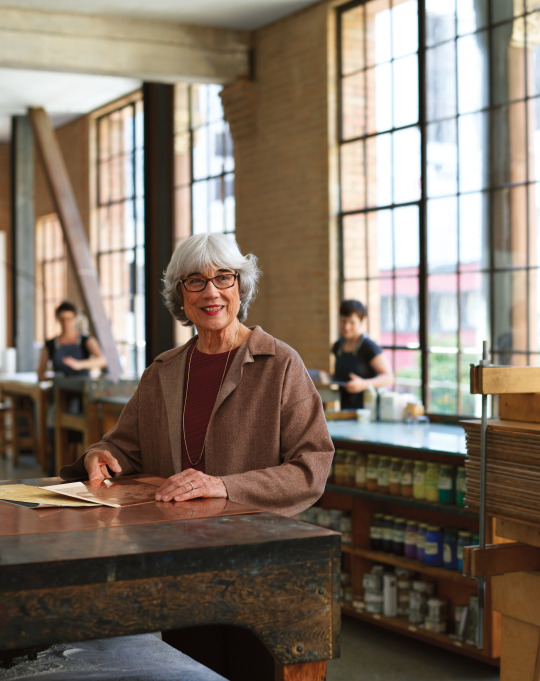
Photo by Laurie Fraenkel.
Crown Point Press is not your typical gallery; not often do you find an entire printing operation in the same venue as a dynamic exhibition space. Kathan Brown, a pioneer of printmaking in the San Francisco Bay Area, started Crown Point Press in 1962 in a storefront in Richmond, California. Moving to Berkeley and then Oakland in the early years, and settling in San Francisco in 1986, Crown Point began by printing and publishing Bay Area artists including Richard Diebenkorn, Beth Van Hoesen, Wayne Thiebaud, and Robert Bechtle. From 1971 through 1976, Brown and her printers also produced artist projects for New York publisher Parasol Press, which sent Sol LeWitt, Brice Marden, Dorothea Rockburne, and other East Coast artists to work at Crown Point.
What began as a studio focusing on the production of etchings has now expanded to the Crown Point Press of today: a renowned etching studio that is also an authority on printmaking and an important presence in San Francisco’s expanding gallery scene. Crown Point's location around the corner from the San Francisco Museum of Modern Art is one reason why visitors to the gallery come from around the world, but the reputations of its artists and the importance of the books it publishes are a stronger factor. A passion for teaching others about the etching process is an essential component of Crown Point's operations and makes the press stand out from a traditional gallery model.
The underlying message behind all Crown Point's operations is the importance of printmaking, especially etching, along with a passion for keeping the art form alive. Its how-to books on hand-printing processes enable artists anywhere to have successful access. Videos of artists working at the press are available online, so anyone can witness the intricacies of the work. Crown Point Press also hosts summer workshops in which people across a spectrum of experiences can try their hands at etching.
We spoke to Brown about opening her own business, her relationships with local artists, the expansion of the workshop into a gallery, and more.
When did you first become interested in visual art?
I come from an art family. My mother went to the Art Institute of Chicago, and was a practicing artist all her life. She never stopped doing watercolors and drawings, even though it was not easy during the Depression when she was working full-time. My father was a professional photographer and we had a darkroom in our house. I made drawings and paintings with my mother and helped my father develop photographs in our basement. Art was all around me when I was young.
How did you originally become interested in etching?
I studied at Antioch College, which was not known as an art school but had a very good liberal education and was experimental back in the days when most colleges weren’t. When I told my art professor I was going to take a year off to study in London, he offered to get me into the Central School of Art. I said, “I’m not an art major,” and he said, “You should be.” He was persuasive. After a year abroad, I came back to graduate from Antioch with a major in art, and after graduation I returned to London for a second year at Central.
At the end of my second year in London I visited Edinburgh and discovered a dismantled etching press in the backyard of the rooming house where I was staying. The landlady said that students had brought it there to save it from being melted down for scrap during the war. “If you want it, you can take it,” she said. I had a plane ticket to return home, and I turned it in, got a ticket on a freighter, and took the press with me. That press is here at Crown Point now, though we have others we use more.

The press from Scotland in the Crown Point studio.
How did Crown Point Press begin?
In 1959, soon after I finished my schooling, I married Jeryl Parker, an artist whom I had met in London. We installed my press in the studio of an artist-friend, John Ihle, and lived in an apartment across the street. Our son Kevin was born in 1961. In 1962 Jeryl and I rented a storefront space in Richmond, an industrial town next to Berkeley, and lived in a little apartment in the back. We set up an etching workshop in the storefront; that year I got a business license for Crown Point Press. Jeryl was teaching at the College of Arts and Crafts in Oakland, and I ran the shop. I didn't publish at the time; a few local artists paid an hourly fee to work in the studio and have technical advice from me. I was also working as a typist for a company that supplied temporary services to banks and insurance companies.
In 1964, Jeryl and I separated and my grandmother helped me buy a house in Berkeley; it had a big basement for the press, and I could look after Kevin while I worked. I was able to hold classes in my basement studio for the University of California at Berkeley's extension program, and I invited artists to do projects that I printed and Crown Point Press published. I also worked on my own art in the studio, and in 1964 published a bound book of my etchings accompanied by poetry by Judson Jerome, whom I had met in my college years.
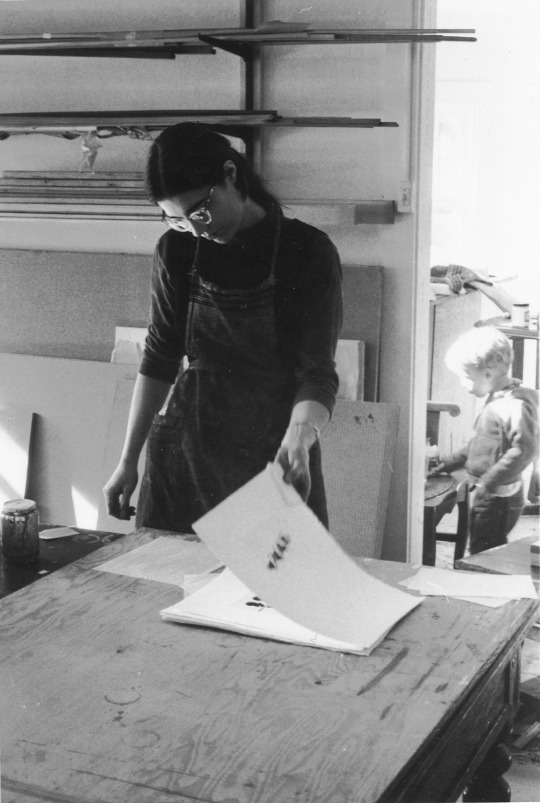
Kathan in the Berkeley studio with her son, Kevin, 1965.
A friend suggested that Richard Diebenkorn might be interested in trying out the etching process. She said he liked using different kinds of mark making, and recommended me to him. He took plates to his studio, and when a painting would get “stuck,” as he said, he would copy the image onto a plate. It would be simplified and print backwards, and this was useful to him. He thought of etching as “a way of drawing.” Diebenkorn was the first artist (besides myself) that Crown Point published. Wayne Thiebaud, who at the time was showing in the San Francisco gallery that showed my own work, was the second.

Richard Diebenkorn, #19, from 41 Etchings Drypoints, 1963, drypoint. Courtesy Crown Point Press, San Francisco.
How did your business grow over the years, from the single press in your home to the current size of Crown Point Press?
In the ‘60s and ‘70s, in addition to holding workshops and publishing and printing artists from California (Diebenkorn, Thiebaud, and Van Hoesen at first, then Bechtle, Tom Marioni, William T. Wiley, Robert Hudson, Chris Burden, Terry Fox), from Europe (Daniel Buren), and New York (John Cage, Joan Jonas, Pat Steir, Robert Barry, Hans Haacke). I also did quite a lot of printing for Parasol Press. Parasol sent New York artists to me: Sol LeWitt, Brice Marden, Robert Ryman, Mel Bochner, Dorothea Rockburne, Sylvia Plimack Mangold, and Robert Mangold. The owner of Parasol Press, Bob Feldman, was very supportive and showed me that it was possible to operate this kind of business.
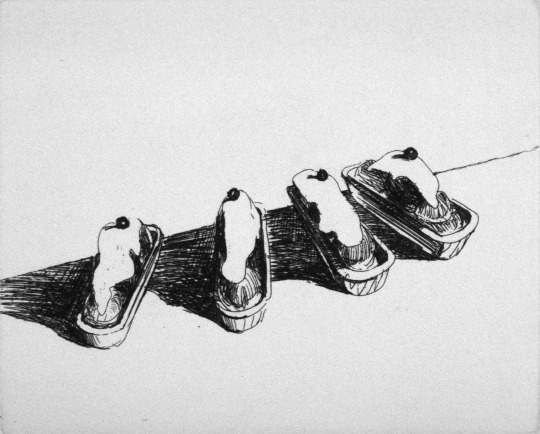
Wayne Thiebaud, Banana Splits, from Delights, 1964. Courtesy Crown Point Press, San Francisco.
What is the structure of the summer workshops at Crown Point?
We usually have ten people in one workshop with three printers. I start out with an introduction, basically outlining the concepts behind the process. Some of the people who attend have experience in the field, but some have never done etching before. Some are laymen in the art world; others are professional artists. Some teach printmaking. In the workshop everyone has a working space and people begin by getting a plate and starting to work. When they run into something they can’t figure out, they go to a printer, and the printer says “You need to use more of this, less of that,” or maybe they demonstrate: “Copy my gesture for wiping the plate.” That’s the way the workshops are run; they are very individual.
I generally poke around in the workshop, talk to people. I don’t actually do any work in the studio anymore, although I did everything there for a long time, and I understand what goes on there. All our Crown Point printers are really good, and they’ve got it figured out; they know exactly how to handle it all.
The workshops are only in summer, but all year long we have tours, lots of school tours and groups from out-of-town museums, so people can get a sense of what’s going on here. We also sell books about printmaking and art in general. We publish some of the books ourselves, usually when we think they wouldn’t exist otherwise.
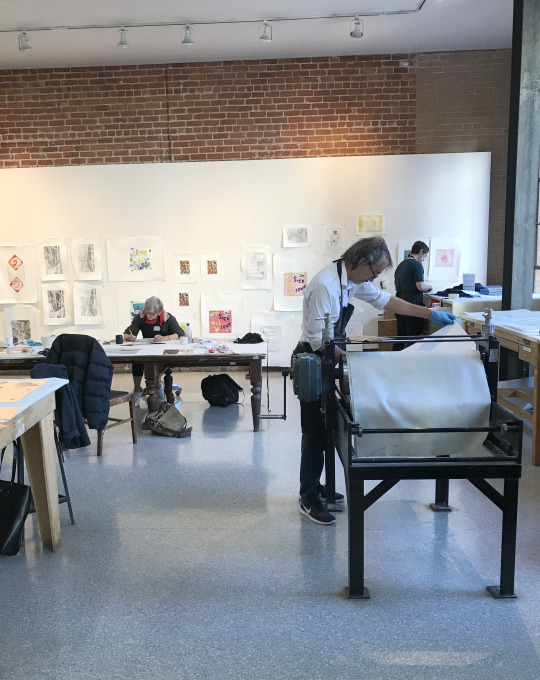
The studio during a summer etching workshop, 2018. Courtesy Crown Point Press, San Francisco.
Have there been any developments in printmaking technology that you’ve used in your workshops?
We pretty much do it the same way Rembrandt and Goya did, except with more color. Not much has changed from back when they did it; I think that’s one of the interesting parts. A lot of the process involves using materials and techniques an artist may not use regularly, such as drawing on copper plates using tar, wax, salt, and sugar syrup. It’s all hand done and the materials are so tactile and beautiful.
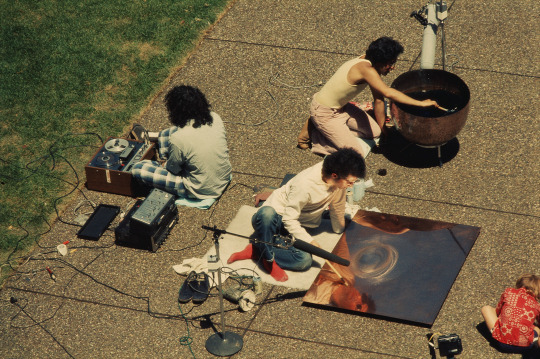
Tom Marioni creating the etching, The Sun’s Reception, Sausalito, CA, 1974. Courtesy Crown Point Press, San Francisco.
How have you balanced the workshops with the operation of the gallery business?
In 1988, I moved Crown Point Press from Oakland to San Francisco, and Valerie Wade joined us. Her title now is Director/Partner. She handles the gallery side of the business, attending art fairs and developing our network as well as planning and hanging our shows. She and I also discuss which artists to invite to create prints here.
How do you choose the artists you invite?
That is the single most-asked question I get at Crown Point, and I am still unsure how to answer it. Valerie and I are glad to have recommendations from artists who have already worked here, and she is in touch with the art world in general through her attendance at art fairs and her day-to-day networking. In our publishing program, we can only accommodate three, maybe four, artist projects in a year because the printing process is so time-consuming; if we are to stay in business, our published artists must already have developed markets. But, don't forget, we also have summer workshops that anyone can join.
Which artists have worked with you recently, and who are you excited about now?
We’re always excited about the artists who work here, and we always have a great time with them. Charline von Heyl has been here fairly recently, and I like her, and her work, a lot. We had a wonderful show of new (and older) work by Darren Almond, who came from England, last fall. Mary Heilmann is very good. We showed her new color etchings last year. And we have a new project scheduled with Laura Owens, who is from Los Angeles and has worked with us before. Also, I'm hoping we might have a new project this year with Wayne Thiebaud, who was one of the first artists I worked with back in the 1960s; we have published his prints regularly over the years.

Charline von Heyl in the Crown Point studio, 2014. Courtesy Crown Point Press, San Francisco.
Can you tell us about the current show in the gallery?
The 2019 springtime exhibition at Crown Point Press focuses on a set of four recent etchings by Los Angeles artist Mary Weatherford. She is known for attaching lighted neon tubes to the surfaces of her paintings; the prints, without neon, have a strong interior light. “Gesture,” the accompanying group exhibition, reaches back into Crown Point's history to Brice Marden’s “Five Plates” of 1973, and includes later work by Pat Steir, Mary Heilmann, Amy Sillman, Charline von Heyl, Jacqueline Humphries, and John Zurier. In June and July we're featuring a bound book of etchings about California by Fred Martin titled “Beulah Land.” Crown Point published it in 1968; this show is part of a citywide celebration of The Dilexi Gallery, which was an important influence in San Francisco's art history.
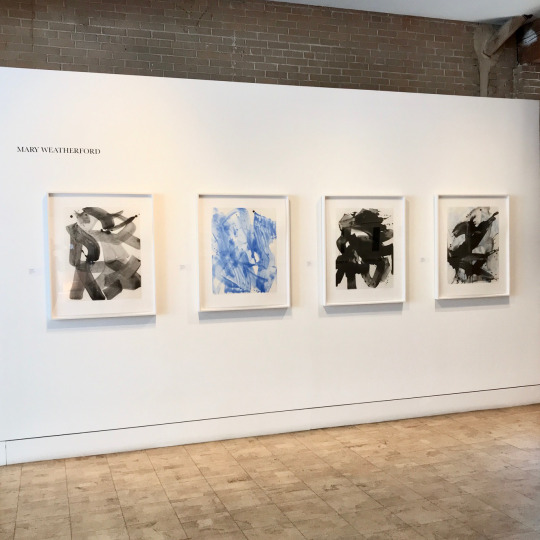
Installation view of “Mary Weatherford,” 2019. Courtesy Crown Point Press, San Francisco.
Do you have any advice for collectors who want to learn more about print as a medium?
I think people are rewarded by close looking. These prints have dimension; it might seem, at first, like they’re printed on a flat sheet of paper, but they are actually embossed into it. This is the only print process that does that; in lithography, woodcut, silkscreen, the ink sits on top.
Etchings have a special energy when you look at them closely. I think that when people are able to see this, a light comes on inside and they think, “oh, this is really something different.” And then the door is open to a real appreciation of the process. We aren't just making a drawing on a plate, putting some ink on it, and printing it. It’s much more complex, and although the artist has technical help from our printers, everything is in the artist's control completely.
If you can visit us in San Francisco, you will be welcome; we give tours that include the studio. (If an artist is working in there, we have a secondary studio you can see.) Some of the people who take our summer workshops are collectors. Some are artists, but we also get people who come in and say, “I’m not an artist, or a collector, but I want to find out how it’s done.” This curiosity is always rewarded. No matter how the drawing starts out, when it’s printed, it looks purposeful, because the printing, in itself, provides a kind of presence.
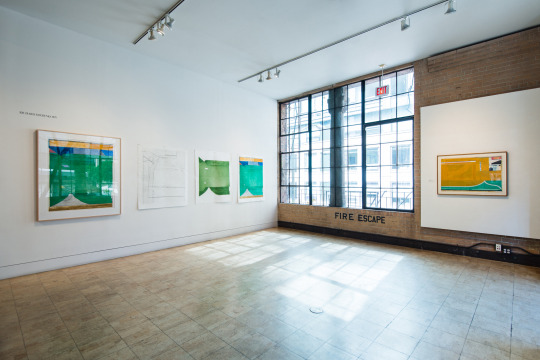
Installation view of “Green by Richard Diebenkorn: The Story of a Print,” 2017. Courtesy Crown Point Press, San Francisco.
Do you have some advice for somebody thinking of opening a gallery right now?
It’s important to establish a close connection to the artists in your network. We learn about interesting artists through word of mouth from the artists we already work with. You also should be ready to pounce on something new as soon as you can. My partnership with Valerie Wade has been essential, as she’s really out in the world and can get a sense of what's going on and which artists might be ready for a project with us.
Looking back, I’m astonished by some of the things Crown Point Press has done. We've printed and published a lot of great art, and the National Gallery of Art in Washington, D. C. and the Fine Arts Museums of San Francisco both have archives of our work. We are lucky to have had a lot of goodwill over the years. Some of the workshop people and printers who have worked here have opened their own workshops. The artists who work with us generally become engaged with what we are doing and often return for another project. We publish books on the etching processes so everyone can learn, and we hope more artists and more printers will become interested in using this medium. The technology is very old, and I think people appreciate the fact that we’re helping to keep it alive.
1 note
·
View note
Text
“We Have to Question Everything We’re Doing” – Veteran Art Dealer Richard Solomon on Bringing Galleries Into the 21st Century
By Stephanie Strasnick

Photo by Carlin Mayer. Courtesy Pace Prints, New York.
“Some collectors want to put art on their walls, live with it, love it, and learn from it,” says Richard Solomon, President of Pace Prints. “Some collectors want to hang it, others want to put it in storage or send it to Delaware. There’s no bad reason for collecting art.” In his five decades at the helm of the famed publishing house and gallery, Solomon has encountered a diverse array of collectors and artists, and has gained invaluable insight into contemporary collecting practices and the ever-changing art market.
Though he attests he is “not much of a salesperson,” the industry veteran has achieved unmatched success in the prints and multiples business and has partnered with more than 150 artists from the 1960s to the present to produce their editions. Since opening their doors 50 years ago, the gallery has mounted hundreds of exhibitions and participated in numerous fairs, including The Art Show and Art Basel.
At the request of his friend, Pace Gallery’s founder Arne Glimcher, Solomon established Pace Editions Inc. in collaboration with Glimcher in 1968. Over the past 50 years, Pace Editions, now renamed Pace Prints, has published over 150 different artists including Chuck Close, Jean Dubuffet, Shepard Fairey, Helen Frankenthaler, Jenny Holzer, Sol LeWitt, Robert Mangold, Yoshitomo Nara, Louise Nevelson, Robert Ryman, and Pat Steir among others. In addition to print galleries on 57th Street and in Chelsea, Pace Prints has a printmaking facility in Manhattan and a papermaking print workshop in Brooklyn.

Helen Frankenthaler, Geisha, 2003, twenty-three color Ukiyo-e woodcut, printed from 15 woodblocks on Torinoko paper and mounted onto Fabriano, Classico paper. Edition of 50. Courtesy Pace Prints, New York.
We sat down with the Boston-born and New York-raised gallerist to discuss the challenges facing 21st-century dealers, the enduring appeal of prints and works on paper, and the curious path that led him from supermarket executive to New York City marketing executive to the reigning King of Prints.
When did you first become interested in visual art?
My mother was a very avid collector. When I was in my early teens, she started bringing me around to galleries and would give me sculptors’ drawings for presents.
Did you continue to learn about and collect art in your late teens and twenties?
At Harvard, I originally thought I’d be a History of Art major but I eventually became a Government major. After graduating college, I went directly to the Harvard Business School and then into the family’s supermarket business. One day my wife and I were walking down Newbury Street in Boston. We looked in the window of a gallery with the name Pace on it. We ended up buying the first thing that Arne Glimcher sold as a dealer.
What inspired you to go into the print business with him?
Arne and I became good friends. Five years after we met, I returned to New York to work as a marketing executive at Clairol. In 1968, Pace Editions, now known as Pace Prints, was started as a separate entity from the Gallery by Arne Glimcher, with me as a silent partner, to publish a work by Lucas Samaras. By 1970, Arne had decided that he wanted to go into print publishing in a serious manner and to establish a print gallery as well. He persuaded me to leave Clairol and develop his vision as the full-time president of Pace Editions Inc.
Arne’s concept was that the Pace Gallery needed the capacity to be responsive to every medium in which their artists wanted to create art. He basically said that to fully represent an artist, Pace should have the facilities to enable the artist do whatever they want. In those days—the 1960s—publishers like Multiples, ULAE and Gemini were working with artists with a variety of gallery allegiances. Arne thought that if Pace Gallery artists wanted to create editions, Pace should have an in-house capacity to facilitate it. He decided that the time was right to make a serious commitment by setting up a separate company as publishers of limited edition prints and multiples and a gallery devoted to prints. He recruited me to make it happen.

Yoshitomo Nara, Untitled, 2010, a series of ten Ukiyo-e woodcuts. Edition of 50. Courtesy Pace Prints, New York.
Was the transition from advertising to art dealing a difficult one?
I was apprehensive to make the move. I told Arne, “What do I know about this business?” He said, “You’ll learn.” And here we are, 50 years later, and I’m still learning.
One of the things I understood about myself at the time was that I was a people person with a relatively decent marketing mentality—but not a great salesperson.
If you didn’t feel your sales abilities were strong, how did you adapt?
I have pretty good eyes, a pretty good sense of quality, and I’ve been able to hire excellent people over the past 50 years—most of whom are still with us if they haven’t retired. Our ability to attract a really good staff has let us thrive. I think that’s been the secret. We have really talented printers and gallery personnel. The Pace Gallery in the early days, supplied all the artists, like Louise Nevelson, Chuck Close, Jean Dubuffet, and Agnes Martin. More recently, Jacob Lewis, in his thirties, has been identifying the talent. Our wonderfully creative printers have enabled us to realize diverse projects with artists in a variety of printmaking processes.

Louise Nevelson, Nightscape, 1975, black cast paper relief. Edition of 75. Courtesy Pace Prints, New York.
How did Pace Prints become the renowned print gallery that it is today?
In 1975, three important things happened: Chuck Close, Agnes Martin, and Jim Dine came to the Pace Gallery.
Why was that important? Jim Dine, in my opinion, is one of the great contemporary printmakers. He loves making prints, and it is part of his DNA. He was a major reason why we actually established an in-house printmaking workshop under the direction of Joe Wilfer, who came to us as a talented printer. Joe’s inventiveness was immediately recognized by Chuck Close—who became a major printmaker for us in collaboration with Joe.
As a result, by the end of the 1970s, we were making prints in our own facilities instead of outsourcing them as we did with a number of artists, including Alfred Jensen, Louise Nevelson, and Jean Dubuffet, during our initial years as publishers.

Jean Dubuffet, Faits Mémorables III, 1978, silkscreen. Edition of 70. Courtesy Pace Prints, New York.
Has it been a challenge keeping the business stable in recent years?
Today is a particularly difficult time to be in the art world, both for art dealers and print publishers. It’s a very different world than it was in the 20th century, and I think we’re all struggling to figure out how to best adapt our businesses to be as successful in the 21st century as we were in the 20th.
Our publishing activities reflect, by necessity, a more diverse group of artists compared to our initial dependence on artists represented by the Pace Gallery. Reaching out to a wider community of artists has had its pluses and minuses. It has been increasingly difficult to get artists committed to showing up at our workshops as artists today are constantly pressured by their galleries to produce unique works for exhibitions, or for the next art fair, or for one of their international affiliated galleries. To say that the artists we want to publish are over-committed is an understatement.
It has also been extremely difficult for print dealers and publishers to get access to art fairs, or preferential placements in them, and it is extremely costly to participate in exchange for a few days of exposure—but art fairs have become increasingly important channels of distribution. All of this has added dramatically to the challenges of operating successful businesses.

Pat Steir, Dragon Waterfall, 2001, four-color screenprint. Edition of 35. Courtesy Pace Prints, New York.
What have you been doing in response to all of these struggles?
We’ve been taking on younger artists, as well as those with greater international visibility. We’ve also been expanding the aesthetic range in our publishing. We are lessening our edition sizes, producing a greater percentage of mono-prints, developing creative approaches to printmaking, and trying to find new methods of distribution and promotion.
The bottom line, however, is that we—like all of my colleagues—have not really solved many of the new challenges that we continue to face.
What is one of the most significant changes you’ve seen in this business in the past decade?
The big change is art itself. Somewhere along the line, contemporary art has increasingly become a fiduciary instrument. Branding has become extremely important. When I was in the supermarket business, we all recognized the importance of brand identification. It is happening big time in today’s contemporary art world.
In the past, artists’ brands—reputations—were created by museum acquisitions and exhibitions. Today, their reputations are more frequently created by market manipulation and social media promotion. They are easier to establish and promote, and often created by forces outside of the art world. A recognizable artist’s brand has monetary, trade, and auction value, and collectors are very conscious of that.

Leonardo Drew, 37P, 2015, pigmented, printed and cast handmade paper. Edition of 1, unique. Courtesy Pace Prints, New York.
What changes are you making in your approach to publishing?
More and more, we’re moving away from asking our artists to consider making print editions and instead we are encouraging them to make mono-prints. In the current collecting climate, uniqueness is frequently more appealing to collectors than owning a work that has been produced in editions. There is often a considerable aesthetic benefit in that the artist’s hand is more apparent in a mono-print. Additionally, in many cases, it is more cost effective as it does not involve producing a number of editions higher than what ends up being sold.
We have recognized that as printers and publishers we need to become increasingly creative in developing new processes such as in our papermaking workshop and our use of technology and new materials. Our skills in this regard have resulted in projects that we might not have dreamed possible when we started our own workshops in the mid-1970s.

James Turrell, Suite from Aten Reign, 2014, aquatint etching. Edition of 30. Courtesy Pace Prints, New York.
Can you pinpoint one of the single biggest issues facing dealers in 2018, and how dealers might confront it?
Besides confronting the facts of the increasing costs of doing business, I think one of the biggest single problems we’re facing today is there is not a spirit of collaboration among dealers. I’m not saying it’s easy. I mean, how do we foster a collaborative environment in such a competitive one?
Possibly some form of consolidation—both national and international—will need to take place. It is happening in almost every industry. Globalization and the costs and pressures of doing business have resulted in the necessity for major structural changes within many industries. Maybe, it needs to happen in the art business in some form.

Shara Hughes, Tree on the Hill, 2018, monotype with oil-based ink. Courtesy Pace Prints, New York.
You seem very open to change and very proactive when it comes to altering your business model as needed. What would you say to veteran dealers who are reluctant to change?
Everybody needs to examine their objectives, think more about collaboration and how they can have a greater impact in their segment of the art world. How can we, as gallerists, get the collectors back into the galleries? We are all paying a very high price for our galleries. It is our number one challenge to increase the returns on our real estate investments.
As gallerists, we need to figure out how to effectively and efficiently attract artists and clients and increase our productivity in all areas of our business. Among the many challenges, figuring out how to compete with the auction houses and art fairs will require learning how to effectively use the Internet as a selling vehicle as well as for publicity and informational purposes.
As with everything else in the 21st century, we all need to reevaluate everything. Success in the past does not relate to success in the future. Much of what we thought we were doing right in the 20th century probably isn’t as applicable in the 21st. We do not have to reinvent ourselves, but we do have to continuously question what we’re doing.
4 notes
·
View notes
Text
Gallery Chat with María Inés Sicardi and Allison Armstrong Ayers on Running Texas’ Premier Gallery for Avant-Garde and Contemporary Latin American Art
By Stephanie Strasnick
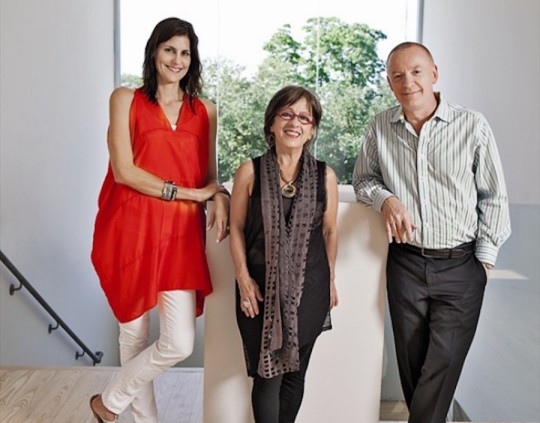
From left to right: Allison Ayers, María Inés Sicardi, Carlos Bacino. Courtesy Sicardi | Ayers | Bacino, Houston.
In the early 1990s, Argentine-born art aficionado María Inés Sicardi noticed that her new home of Houston, Texas, was devoid of art spaces dedicated to avant-garde and contemporary artists from Latin America. In 1994, Sicardi corrected this contemporary-art oversight by opening her gallery, which shines a light on both emerging and established Latin American artists.
In the years since the gallery’s 1994 opening, much has changed for Sicardi: she formed a partnership in 2000 with Allison Armstrong Ayers and Carlos Bacino. In 2012, the group built a 5,900-square-foot complex designed by Brave Architecture. The new building, located across from the Menil Collection, allowed the gallery more space for exhibitions.
Now known as Sicardi | Ayers | Bacino, the gallery has participated in art fairs and exhibitions around the world and has an impressive roster of Modernist masters and acclaimed figures in contemporary art, such as Liliana Porter, Miguel Ángel Rojas, and Gabriel de la Mora.
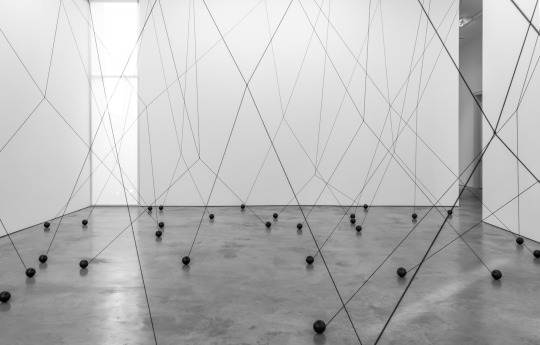
Installation view of “Magdalena Fernandez: Flexible Structures,” 2015. Courtesy Sicardi | Ayers | Bacino, Houston.
On view through the summer, the gallery presents a solo exhibition from Texas-born artist Thomas Glassford, who is best known for his architectural installations made from everyday materials, like plates and broomsticks and gourds. Later this year, the team will honor the late Mercedes Pardo—a Venezuelan artist recognized for her abstract paintings and works on paper—with a solo show.
We recently spoke with two members of the team—Sicardi and Ayers—about their 18-year partnership, the benefits of establishing an art space in Houston, and what’s next for the gallery.
Tell us about your background and how you first become interested in the art world.
Sicardi: I am originally from Buenos Aires, but I’ve been in the U.S. for 29 years. I studied art in college and when I moved to Houston, I knew I wanted to do something related to art. I opened the gallery in 1994. We specialized in Latin American art because I felt there was a need for it given the connection between Latin America and the United States. Houston, to me, was the natural bridge.
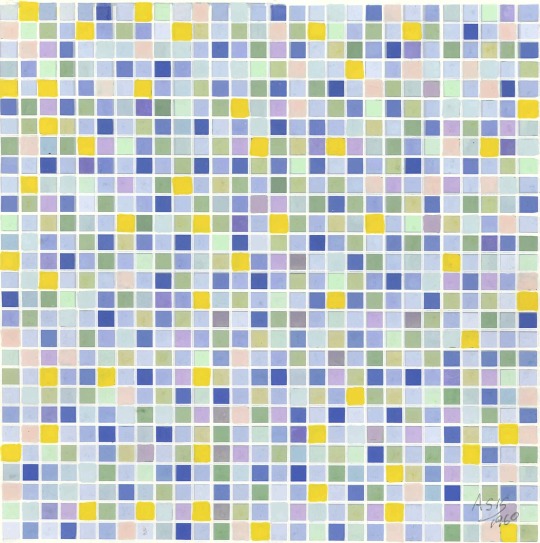
Antonio Asis, Untitled, 1960, gouache on paper. Courtesy Sicardi | Ayers | Bacino, Houston.
What was the gallery like in those early years?
Sicardi: The gallery space was very small in those days. I worked closely with a photography curator during this time and connected with galleries from Buenos Aires and Mexico. We moved to a larger space in 2001, months after the gallery became a partnership. This move gave us the possibility to start showing masters. We opened the space with Taller Torres-Garcia. This allowed us to create a dialogue between the younger and older generations of artists. Many of the artists I found through my extensive travels during this period still work with the gallery. I discovered them through museum exhibitions, studio visits, and word of mouth.
Ayers: A lot of people don’t realize that for the first six or so years of the gallery, we only worked with contemporary artists. A lot of people only associate us with the master artists we represent. We have worked with Oscar Muñoz, Liliana Porter, and Pablo Siquier since the late 1990’s.
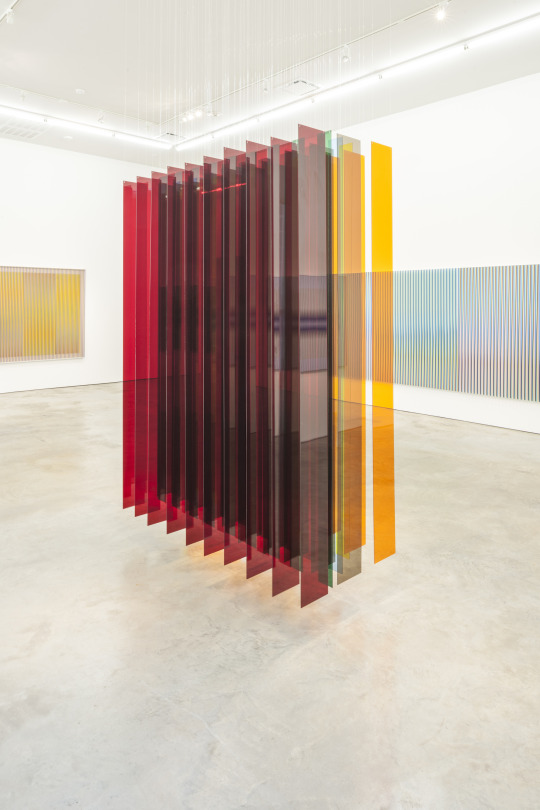
Installation view of “Carlos Cruz-Diez: La Autonomia del Color,” 2017. Courtesy Sicardi | Ayers | Bacino, Houston.
Alison, how did you come to art as a profession and when did you join the business?
Ayers: I have a minor in art history and after college ended up going into advertising and marketing. I did that for several years and it was during that time that my husband and I met María Ines. That was in 1996 and the following year I began working on marketing and editorial projects for the gallery. In 2000, we became partners.
When did your third partner, Carlos Bacino, join? How did you meet?
Sicardi: Carlos came into the gallery one day and expressed a great interest in art. He loved it and started to come back every Saturday and collected work bought from us. He is from Argentina and brings a really sharp, rational business prospective. Though I started the business on my own, I wanted to have partners since I’d had a positive experience with a partner back in Buenos Aires. I also felt that it was impossible to accomplish what I had envisioned for the gallery alone. I wanted to make the gallery larger and share my experience, and it has worked out very well with Carlos and Allison. Both he and Allison have been with me since 2000.
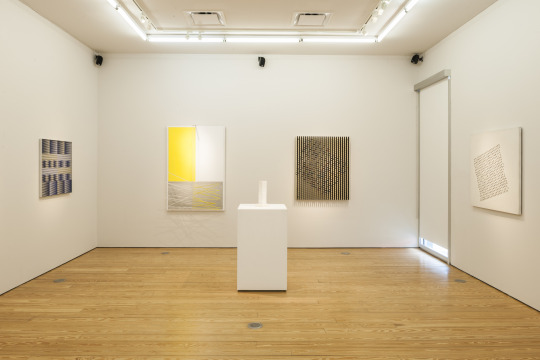
Installation view of “Masters,” 2018. Courtesy Sicardi | Ayers | Bacino, Houston.
With three different partners—and opinions—in the mix, how do you create a consistent program?
Sicardi: The gallery has carefully defined its line of work through the years. In the beginning, we were showing younger artists from South America. Once we became a partnership, we added masters to the programming. And, after a trip to Venezuela, we began to incorporate a group of artists who focused on kineticism and geometric abstraction. These artists were based in Paris and South America.
Ayers: We each bring different things to the table. My husband is a lawyer and is very involved with the gallery. His practical business background and research is instrumental to our program. Carlos, who is a geneticist, brings his practical and business background to the group as well. We all balance each other. We’re not going to agree on everything, but one thing we have to agree on is that we won’t show an artist unless we have full approval from the group. We’ve had many wonderful experiences and feel fortunate to work in a field that has seen so much growth and international recognition.

Luis Tomasello, Atmosphère chromoplastique No. 1014, 2012, acrylic on wood. Courtesy Sicardi | Ayers | Bacino, Houston.
Because you show primarily international artists, do you find that your collector base is mostly international as well?
Ayers: Given the nature of what we do, our client base has always been a combination of American and Latin American collectors, institutions, and museums from the United States and abroad. We’ve had a lot of success locally, in Texas. One thing that’s special about Texas is that everyone has been so welcoming, so open-minded. Houston, in particular, is amazing—it’s the fourth largest city in the country, has a large international population, and is home to really great museums and patrons.
Sicardi: We have many collectors from Latin America and the United States. We’ve participated in Art Basel Miami Beach and The Armory Show for more than ten years, which has allowed us to expand our base in the Latin American countries, the United States, and Europe.

Installation view of “Marco Maggi: Putin's Pencils,” 2017. Courtesy Sicardi | Ayers | Bacino, Houston.
Can you tell us about your upcoming exhibitions?
Ayers: We are working on a solo exhibition for Mercedes Pardo in September. Mercedes was married to the Venezuelan kinetic artist Alejandro Otero and has an amazing body of work that has not had much exposure in the United States. We will also screen a new video by the Colombian artist Maria Fernanda Cardoso. A little later in the fall we will show Miguel Ángel Rojas and Manuel Espinosa.
What advice do you have for working artists today?
Sicardi: My advice to artists would be for them to do what they feel that they need to do and not focus too much on the market—that’s very important. The work itself matters, not just selling and marketing it.
Ayers: Chose a dealer who understands you and with whom you can have communication. We believe in making a long-term plan with our artists and working on all aspects of their career.

Thomas Glassford, Labrys, 2018, lacquer on MDF. Courtesy Sicardi | Ayers | Bacino, Houston.
Advice for new collectors?
Sicardi: Similar to my advice for artists, I think it’s important for collectors to follow their intuition and realize that knowledge is the key to building a good collection.
Ayers: For new collectors, I’d advise seeing as much as you can, educating yourself, taking notes, asking questions, don’t ever feel like you have to buy impulsively. It should take time to build a collection.
What would you say to someone interested in starting her or his own gallery?
Ayers and Sicardi: Surround yourself with a good group of people and know that you can’t do everything yourself. You need professionals in all areas and you must have a long-term plan.
6 notes
·
View notes
Text
Gallery Chat: The Founders of Corbett vs. Dempsey on Elevating Midwestern Art, Why Collectors Should be Obsessive and Fall in Love with Art, and More
By Stephanie Strasnick
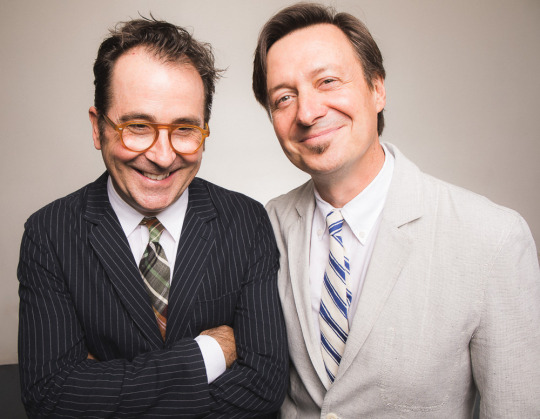
Jim Dempsey and John Corbett. Photo by joe mazza / brave lux inc.
“The thought of having a gallery didn’t occur to us until five minutes before we had a gallery,” recalls Jim Dempsey, who co-founded Chicago’s Corbett vs. Dempsey gallery 14 years ago with business partner John Corbett. The two had first met at the School of the Art Institute of Chicago and developed a friendship off campus at various film and music events, connecting over their shared interest in the mediums. After collaborating on a series of screenings at Dempsey’s art-house movie theater, the pair toyed with the idea of dealing rare, historic and curious works by Chicago artists in a storefront. Their real estate search brought them to the sprawling top floor of a friend’s record store, which was too large for the small enterprise they first envisioned, but just right for an exhibition space. “If we’d have gone home and thought about it, we would have talked ourselves out of it,” remembers Dempsey. Instead, they committed to the space on the spot with a handshake, marking the beginning of a fruitful 14-year partnership.
In the early years of Corbett vs. Dempsey, the gallery’s program was deeply rooted in the history of art in the Midwest. Together they uncovered what was in many ways a forgotten generation of artists and the two became known for their exhibitions of mid-century Midwestern art. Their first show featured WPA cityscapes by Modernist painter Eve Garrison, and the second highlighted works by erstwhile Chicagoan Jimmy Wright. Though the lifelong Chicagoans haven’t lost touch with their Midwestern roots, their program has evolved to include artists from across the country (such as Joyce Pensato, Christopher Wool, and Charline von Heyl). Currently, the gallery has a solo exhibition by Josiah McElheny. “Cosmic Love,” his second show at the gallery, features all new work and offers a teaser of his installation at the upcoming Carnegie International. Corbett vs. Dempsey is also participating in Condo New York, a gallery sharing initiative developed in London in 2016. Bortolami, a fellow ADAA member, will be hosting presentations by gallery artists Rebecca Morris and Ed Flood.
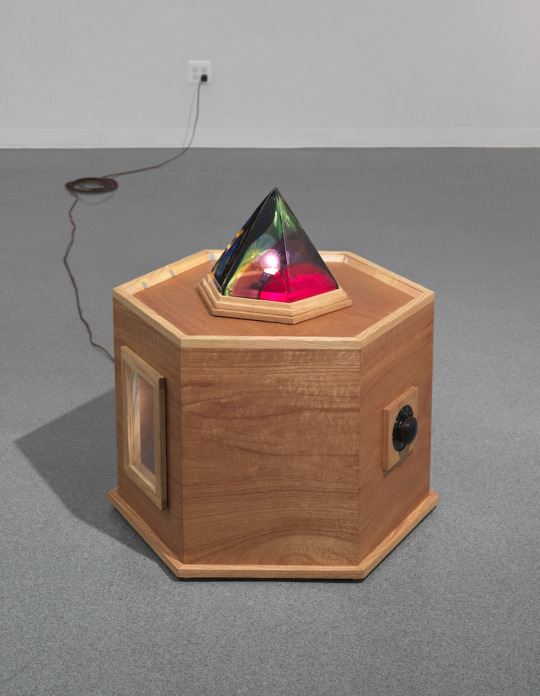
Josiah McElheny, Color Time—Model One, 2014, handblown molded and polished glass, marine plywood, red oak, AC gear motor and inverter, Variac control knob, electric lighting, electric wiring, sheet glass, mirror, hardware. Courtesy the artist and Corbett vs. Dempsey, Chicago.
The Chicago-based duo talked with us about their decade-and-a-half-long collaboration, the multi-faceted history of Midwestern art, and why the key to collecting is “falling in love with things like you fall in love with a person.”
What first attracted you to visual art?
Corbett: When I was a kid, my father turned me onto painting. He took me to an art museum, sat me down in front of two very different paintings, and made a point that you may like one or the other, but they’re both worth looking at. That was really interesting to me—this idea that they could be so different, yet both so engaging. That stuck with me from then on.
How did this interest in painting manifest itself into a career in the arts?
Corbett: Well, I was really a closet visual art person all along, in terms of the things that I was doing, listening to, writing about and so on. I started teaching at the School of the Art Institute of Chicago in 1988, mostly focusing on sound and music then migrated my way through the school as my interests shifted. When the chair of the Exhibition Studies program went on sabbatical, I filled in for a year and that was a bridge to curatorial for me—and then I met Jim.

Magalie Guérin, Untitled, 2017, oil on canvas on panel. Courtesy the artist and Corbett vs. Dempsey, Chicago.
How did you two first meet?
Corbett: We knew each other because we were both culture vultures. Although we were both at the School of the Art Institute at the same time, I was there teaching while in graduate school and Jim was there going to art school. We were theoretically in the same space, but we really knew each other from the music and film scenes.
What inspired you two to start a gallery together?
Corbett: Jim and I started getting interested in the history of our own city’s visual art and why we, as lifelong Chicagoans, knew so little about the art history of Chicago. We began exploring that angle through our exhibitions because at that time, there were big holes in the scholarship, and in the exhibition history. That curiosity was kind of what lured us into the business. The path to the gallery was a little different for Jim, though, so I’ll let him tell his version of the story.
Dempsey: I didn’t grow up in a family that went to museums—art was a bit of a mystery to me. But in school I became sort of a marvel at making things, I always cut the best looking pumpkin at Halloween. I wasn’t involved in the real art world until after high school, when I took a painting class at a community college. I went to art school, had a lot of studio practice for many years, and I used to run an art-house movie theatre.
Once, I was programming a series of Sun Ra films. I knew that John was an authority on the extraterrestrial musician Sun Ra and invited him to help me. We became friends through that experience and started working together on other projects after that. Then at some point, we decided that we need to kind of pair up and actually try to curate some exhibitions.
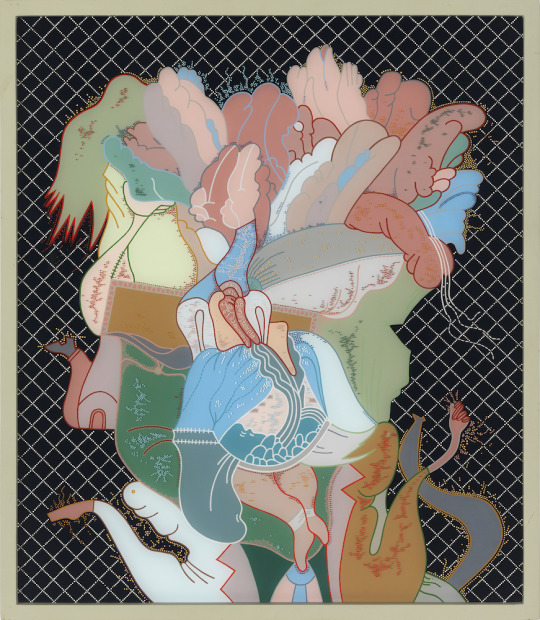
Barbara Rossi, Rose Rock, 1972, acrylic on Plexiglas in artist’s frame. Courtesy the artist and Corbett vs. Dempsey, Chicago.
John mentioned that we were very interested in the history of the Midwest, and the more we learned the weirder it got. We realized that there was a great story to tell through art—a puzzle we could put together in a logical way. When I got out of school, I started doing research and started finding out more about the work of some of my former Art Institute teachers, who were artists, and it just felt like we were really doing historical—almost anthropological—work. It was endlessly fascinating.
Tell us about your first official exhibition at Corbett vs. Dempsey.
Corbett: Our first exhibition, in 2004, was WPA cityscapes from the late 1930s to the early 1940s by an artist named Eve Garrison. She was a Chicago painter and the head of a group called No-Jury Society, which fought for exhibitions at public institutions to be selected without judges. She was a really great Realist, figurative painter and, in the 1940s, she started to shift to a very strange kind of homespun Surrealism.
When and why did you start showing more artists from outside of Chicago?
Corbett: Originally, we were digging things up that collectors hadn’t seen yet. We ended up building a small market for mid-century Chicago art and we showed about 70% Chicago artists, 30% artists from outside Chicago. In 2008 we felt that was no longer the right mix. We were showing Chicago art to Chicagoans, which had been done before. It seemed like a better idea to broaden the reach, to show historical Chicagoans to the rest of the world and give interesting contemporary non-Chicago work a Chicago venue for the first time.
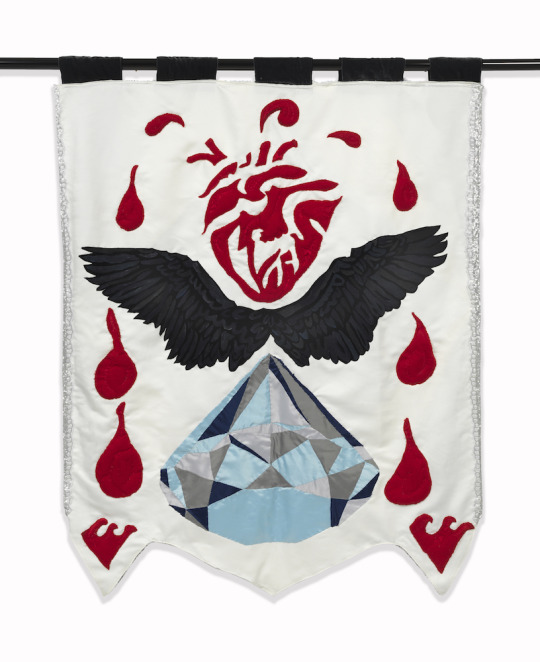
Cauleen Smith, Stop, 2017, satin, poly-satin, upholstery, wool felt, silk-rayon velvet, embroidery floss, acrylic fabric paint, and sequins. Courtesy the artist and Corbett vs. Dempsey, Chicago.
What sets Chicago apart from other cities? How would you describe the Chicago aesthetic?
Dempsey: The Midwest in general can be a place where you see some great things that don’t look like anything anywhere else. If you’re going to compare Chicago to, say, New York, the market pressures are much different. Historically, artists here were freed from those pressures and could explore things that move them—they just followed their muse. They followed each other and supported one another. I think this city also benefited from the incredible collections that were here, particularly the private Surrealist collections. Surrealism made its way into the museums, and then it got into the blood of some of the artists and the students, and ended up in their work.
One of the unique features of your gallery is that it also has its own record label. How did that happen?
Corbett: I had a record label before we started the gallery and it made sense to pull the label over from where it had been operating to the gallery. We changed its name to Corbett vs. Dempsey to be consistent. We put out 10 CDs a year—ranging from experimental jazz to free, improvised music—and we present live music in our gallery space periodically.

Various CDs published by Corbett vs. Dempsey. Courtesy the artist and Corbett vs. Dempsey.
You’ve been working together for 14 years. At this point, are you typically on the same page when it comes to your program?
Dempsey: We respond to things in similar ways. When you find somebody who you jive with like that, the work can be easy. But you know, there are times when we do hash it out. We made a pact early on that we would only show work that really resonated with us and that really moved us. We wouldn’t make a show that we secretly didn’t like just for economical reasons. We can only be truthful to ourselves so we have to work with stuff we love. Now, there are things that John has championed that maybe I was not quite as keen on, but we trust each other’s instincts.
Do you have advice for aspiring dealers?
Dempsey: Don’t think more than five minutes about it, otherwise you’ll talk yourself out of it.
Corbett: I’d actually think long and hard about starting a gallery now because it’s a different world than it was 14 years ago. To start a gallery in New York or Los Angeles—just to keep the door open—is very difficult. Give it a long think—or do what Jim said and don’t think about it at all.

David Hartt, Carolina I, 2017, archival pigment print mounted to Dibond. Edition of 6 + 1 AP. Courtesy the artist and Corbett vs. Dempsey, Chicago.
Words of wisdom for budding collectors?
Corbett: I come at collecting from having collected something of a lesser monetary value—vinyl records. I’ve been a collector since I was a kid and my idea about collecting is to be obsessive about it. I get obsessive about things and want to find them and want to sometimes find unusual examples of them—rarity is key for record collectors. So, my advice? Become obsessed. The most interesting collections are the ones where you walk in and that collector knows a lot more than you do about their stuff.
Dempsey: For young collectors, it’s about falling in love with things like you fall in love with a person. Some of the most amazing experiences John and I have had are seeing well-honed, lifelong collections. They weren’t created by people who were following trends or treating their art collection like the stock market. When you see a Warhol next to a work by somebody you’ve never heard of, that means the collector loved both of those things equally, and that’s when you see somebody’s true soul, who they are, and what they want to surround themselves with.

Diane Simpson, Apron X, 2005, aluminum and leather. Courtesy the artist and Corbett vs. Dempsey, Chicago.
3 notes
·
View notes
Text
“You Need Energy and Conviction” - Gallery Chat with San Francisco’s Rena Bransten
By Sarah Evers

Hung Liu, Rena, 2018, oil on canvas. ©The artist. Courtesy Rena Bransten Gallery.
Since the start of her art-dealing career in the mid-1970s, Rena Bransten has ridden the seismic shifts of San Francisco’s gallery landscape with success and style. While many come to art dealing from a sales background, Bransten established herself as a gallerist from the perspective of an avid art collector. In 1974, on something of a whim, she partnered with her colleague and friend Ruth Braunstein to open Quay Ceramics, a gallery focused on artists creating experimental works in the medium, many based in Northern California. Early artists shown included feminist icon Judy Chicago and ceramic master Ron Nagle.
Soon after, however, Bransten—and many of the artists she exhibited—wanted to expand the gallery’s scope to show a wider range of works in other materials. So in 1979, she presented the gallery’s first non-ceramic show, featuring mixed-media photography by Judith Golden, and changed the gallery’s name to Quay Gallery. In the early 1980s, she renamed the gallery once more—this time eponymously—and her illustrious journey as one of San Francisco’s leading art dealers took off. In addition to running Rena Bransten Gallery for decades, Bransten has served on the boards of several important Bay Area institutions, including the Yerba Buena Center for the Arts. Her tenure there first exposed her to the systemic racial inequality in the art world, an eye-opening experience that changed the gallerist’s perspective—and programming—forever.

Rupert Garcia, Hoodwinked, 2017, pigmented acrylic inkjet on paper. Edition of 10. Published by Magnolia Editions. ©The artist. Courtesy Rena Bransten Gallery.
Ever looking forward, Bransten recently relocated the gallery to the city’s new, dynamic Minnesota Street Project—a community space for galleries, nonprofits, and artist studios in the Dogpatch neighborhood. The new project space encourages in-person visits to galleries during a time when foot traffic is dwindling due to art fairs and the Internet, and houses other prominent San Francisco galleries, including the ADAA’s own Altman Siegel and Anglim Gilbert Gallery.
Bransten continues to add pioneering artists to the gallery roster regularly. Recent additions include Jonathan Calm, who explores the intersection between photography and urban architecture; Lewis Watts, whose photographic works link historical material to contemporary African diasporic communities; and recent MacArthur “Genius” Grant recipient, Dawoud Bey, who is known best for his powerful portraits.

Lewis Watts, Billie Holiday’s Passport, Courtesy of John Goddard, Village Music, Mill Valley, 2006, archival pigment print. Edition of 10. ©The artist. Courtesy Rena Bransten Gallery
Always interested in using the gallery space to engage with contemporary societal issues, the gallery’s first exhibition in the Minnesota Street Project space was “These American Lives,” a group show featuring provocative works by Vik Muniz, John Baldessari, Helen Levitt, Danny Lyon, and other luminaries. Among the works on view were Lyon’s foreboding photograph of an approaching storm over a small American town, and Baldessari’s unsettling comparison between a roller coaster and an electric fence—together juxtaposing the fantasy and the reality of the American experience.
This summer, the gallery is presenting “The Portrait Show” from June 23 to August 18, including works by Robert Arneson, Dawoud Bey, Oliver Lee Jackson, Thomas Ruff, and Henry Wessel, among others. It is also participating in the inaugural edition of FRONT International—a Triennial exhibition curated by artist Michelle Grabner that will present artist commissions, performances, films, and public programs across a variety of cultural venues in Cleveland, Akron and Oberlin, Ohio.

Oliver Lee Jackson, No. 11, 2017 (10.1.17), 2017, oil on panel. ©The artist. Courtesy Rena Bransten Gallery.
We spoke with Bransten about why she loves having a gallery in the Minnesota Street Project, what qualities new collectors need to have, and more.
What first sparked your interest in art?
I grew up in New York City and went to Dalton—a school that was very art-oriented. In fact, Rufino Tamayo was teaching when I was young. My father built an extraordinary manuscript collection but, for me, that didn’t really develop into an interest in contemporary or modern art. After I graduated from high school, I went to Smith College, which had a very fine Art History department, and that’s what I majored in.
Because I graduated a long time ago, we didn’t really study artists of color. And it really wasn’t until I came to San Francisco, when I went on the board of Yerba Buena Center for the Arts, that I realized it was such a glaring gap. On the board was an artist named Amalia Mesa-Bains. She’s the one who made me ask, “how could we just ignore artists of color?” All of a sudden it dawned on me that the art world was very limited in the 1970s and 1980s. I learned a lot from the artists, truly.
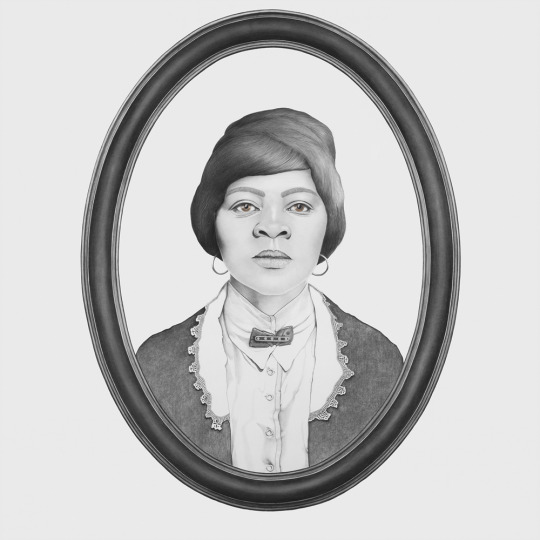
Lava Thomas, Looking Back I, 2014-2015, graphite, conte crayon, watercolor on paper. ©The artist. Courtesy Rena Bransten Gallery.
Why did you open your own gallery?
When I first moved out here, I would go to galleries. One of the galleries was owned by Ruth Braunstein. I went in one day and she said, “You know Rena, I asked someone if she would join me in being a partner in a ceramics gallery, and she said no.” Then she asked, “Can you think of anybody?” And without thinking, I said, “Well what about me?” And that’s how I got into business. And believe me, I would never, never do that now. It’s a very complicated business today. It was very different then.
Why the initial focus on ceramics?
Ruth wanted to focus on ceramics simply because there were a lot of people, on the West Coast particularly, working in ceramics at the time. After a while though, some of the artists we were showing came to me and said, “We don’t want to exhibit in a ceramics gallery.” So I told Ruth that I would like to show other things.

Robert Minervini, Improvised Garden VI (Pacific Heights), 2017, acrylic on canvas. ©The artist. Courtesy Rena Bransten Gallery.
How did you decide which artists to show first? Were they artists you were collecting?
I think it was a little bit of everything. I asked around, but a lot of artists came to me because in those days a lot of the artists were teaching. They were teaching at the California College of Arts and Crafts (now California College of the Arts), or the San Francisco Art Institute or UC Berkeley, and so they had students they would recommend.
How did your experience as a collector help you in running a gallery of your own?
Though I didn’t have a business background at all, it was still sort of a social business in those days. People came into the gallery and sat and talked. It was a different time. There was no Internet, and no art fairs, which changed the business.

Candida Hofer, Elbphilharmonie Hamburg Herzog & de Meuron Hamburg X, 2016, C-print. Edition of 6. ©The artist. Courtesy Rena Bransten Gallery.
Have you noticed many changes with the development of San Francisco, in terms of the reopening of SFMOMA and the expansion of the art scene?
You can’t open a newspaper or magazine or website that doesn’t talk about changes. Some of these galleries are getting so humongous and opening in twelve different cities, and other galleries are trying to continue the way we started. I think the gallery scene changed here with the Dilexi Gallery in the 1960s, which was much more of a New York-type gallery than the galleries that had been here before. And then SFMOMA made it more sophisticated as well.
With the globalization of the art world, it’s a different world than what I remember. At the time, you never thought about looking at artists from all around the world. Part of it is wonderful, but part of it is overwhelming.
What’s your experience like being part of Minnesota Street Project?
I really can’t speak highly enough of it. Several years ago, a couple bought three buildings here in an area called Dogpatch, which was really sort of an undeveloped, light industry area. They came to my daughter Trish Bransten and said, “We’d like you to see one of the buildings, we’re thinking of making two of the buildings for galleries and one building for artists’ studios.” San Francisco rents were going so crazy that artists were leaving the city and galleries were either closing or leaving the city as well. So we came to this warehouse, which was just a plain old warehouse, and they took us around and we said, “If you want us we’re in!”
So we came here, and we have the most absolutely beautiful space. There are about eight galleries always here like we are, but there have also been pop-up spaces run by New York galleries—such as bitforms gallery and Invisible-Exports—and recently we’ve had graduate students having their final show here. It is about two-and-a-half years old. People really enjoy coming here because it is a community and a destination.

Installation view of “David Linger: The Sea Within / O Mar Adentro,” 2018. Photo by John Janca. Courtesy Rena Bransten Gallery.
What summer exhibitions do you have planned?
We are exhibiting a group show of portraits from June 23 to August 18 in the gallery.
In July, we will participate in the contemporary FRONT in Cleveland with our artist Dawoud Bey, who recently received a MacArthur “Genius” Grant. It should be very interesting. We are very excited. The photographic series “Night Coming Tenderly, Black” depicts dark landscapes of safehouses and other places that were important sites of the Underground Railroad in Cleveland. The photographs will be displayed in St. John’s Episcopal Church.

Dawoud Bey, Night Coming Tenderly, Black: Untitled #20 (Farmhouse and Picket Fence I), 2017, gelatin silver print. Edition of 6. ©The artist. Courtesy Rena Bransten Gallery.
What advice would you give to an aspiring art dealer today?
I think you need to start out with energy and with conviction. A lot of the very young people starting out are doing that but it’s still tough. But it’s wonderful at the same time. You do meet great people and the artists are always stimulating. It’s a challenging thing to try to think of a show that’s interesting and that’s going to bring people in to hopefully buy something.
What advice do you have for new collectors?
You have to be adventurous, you have to want to look at things and want to feel. Try to understand what’s happening even if it’s not part of you—if that makes any sense.

Vik Muniz, Repro: Musee d'Orsay (Rochefort's Escape, after Manet), 2016, digital c-print. Edition of 6. ©The artist. Courtesy Rena Bransten Gallery.
5 notes
·
View notes
Text
“San Francisco Collectors Are a Great Community to Work With If You Are Interested in Ideas” - Claudia Altman-Siegel
By Nicole Casamento, May 2018

Claudia Altman-Siegel. Photo by The Morrisons.
During the height of the Great Recession—on a whim and without a plan—Claudia Altman-Siegel relocated from New York to San Francisco. The impromptu move spurred Altman-Siegel to open her own gallery and soon propelled her into the spotlight as a rising star in the city’s contemporary art scene.
Founded in 2009, Altman Siegel grew as the economy recovered and the tech boom flourished, providing a more international platform for California artists, while introducing California collectors to artists from other parts of the globe. SFMOMA’s SECA Art Award winners Zarouhie Abdalian and Liam Everett, and MacArthur genius grant recipient Trevor Paglen are just a few of the luminaries on the gallery’s roster today.
Like many San Francisco galleries, Altman Siegel recently migrated to Dogpatch—San Francisco’s burgeoning new arts district. Part of the Minnesota Street Project—a three-building structure that now houses many artist studios, prominent galleries and more—the new space provides a larger platform for the gallery’s artists during San Francisco’s current cultural renaissance.

Claudia Altman-Siegel and Laeh Glenn in Altman Siegel’s new space in Dogpatch. Photo by The Morrisons.
We spoke with the daring dealer about her first job as a gallery security guard, why she loves San Francisco’s collectors, what advice she thinks aspiring gallerists should ignore, and more.
How did you know you wanted to work in art professionally?
I was into art my whole life. I was one of those nerds who hung out in the art department all the time in high school and then I went to Barnard to study art history, and minored in fine arts. During college, I subscribed to Artforum and went to see as many gallery exhibitions as I could. I specifically moved to New York to be near the art world. I sort of always knew what I wanted to do…
What was your first art world job?
A security guard for a Jackson Pollack painting at Luhring Augustine! Fellow ADAA member Michele Maccarone was in my class at Barnard. We were friends in college and took art history together. She interned at Luhring Augustine and got a job there right after graduating. Shortly after that, I was looking for a job and they were working on an exhibition titled “Eight Painters,” curated by Steve Wolfe.
They had a lot of great work in the show, and there was a really small Jackson Pollack painting they wanted someone to watch to make sure no one put it in their bag. So, I sat in the gallery for about a month to make sure no one took it. Then a position opened up within the gallery and they hired me full time. Within two years, I became one of the directors. When Michele left to start her own gallery, I became their senior director. I stayed there for 10 years.
Why did you move to San Francisco?
I moved here on a whim. I’m from the east coast originally, and I didn’t have any roots here. I just wanted to see what life was like outside of New York. My sister got transferred to San Francisco for work and I just kind of came. I thought I would only be here for a short time and move back to New York but when I got here I realized there were great museums, an amazing collector base, a lot of really talented artists—but very few galleries. And none doing what I knew how to do coming from Chelsea. So, I decided there was a niche I could fill here and decided to stay and open the gallery.
How would you describe your gallery program?
For the most part, they’re all young, museum-level conceptual artists. In the beginning, I put together a strong group of artists, and they have been growing with the gallery the whole time.

Simon Denny, Formalised Org Chart/ Architectural Model: Apple Campus 2 MacPro, 2015, CNC cut MDF, Apple Mac Pro Quad Core 3.7, UV print on Revostage platform, powder coated steel. Courtesy the artist and Altman Siegel, San Francisco.
How has San Francisco changed since you’ve opened the gallery?
I think the biggest change is economic. I moved here at the end of 2007, so I was here when the crash happened, but I had only been here about a month. Since then, the economy has been growing at light speed. San Francisco is the center of industry right now due to the tech boom. So, it’s gotten much more expensive and much more crowded. It’s gentrifying pretty fast, which by New York standards seems normal because New York gentrifies quickly all the time, but here it wasn’t like that for a really long time, and it’s a new phenomenon for the city.
Are there fewer artists living there now?
Not fewer. San Francisco’s always been sort of a transitional town. A lot of people start here, stay for a while, and then move on to other places, but that’s always been the case. I think one of the things that make it hard is that there hasn’t been a lot of opportunity for contact with the international art world or the larger art world compared to cities like Los Angeles and New York. There are just fewer galleries here. One of the things I wanted to do was to find the best local talent and let them step into that world. I hope that the gallery can provide enough of a platform to artists so that they don’t have to move if they don’t want to.
How would you describe the collecting community in San Francisco?
San Francisco is very collegial and inclusive. It’s ultimately like a small town where everybody knows each other and the collecting community is very nice and supportive. I really love them. San Francisco collectors are very smart, and there’s not a lot of conspicuous consumption here, so people are not motivated to buy something just because someone else has it. It’s harder to make sales sometimes, but when people buy a work it’s because they really love it and are interested in the ideas and supportive of what’s behind it. San Francisco collectors are a great community to work with if you’re interested in ideas.
In a 2012 interview with ARTCARDS, you said that you see yourself as a dealer and a gallerist. What did you mean by that?
I meant that there are two sides to this job. One is doing the creative programming and the other is being a salesperson. Some people are dealers who focus on sales and hire curators to do the creative programming. Some do it the other way around. I try to do both.

Installation view of “Will and Be Going To,” 2016, at Altman Siegel.
What advice would you give to an aspiring dealer?
Put your program first and do the most that you can with the means that you have. And everyone tells you that it’s impossible to make it, but you just can’t listen to that.
What advice would you give to an aspiring collector?
Remember that collecting is as much about philanthropy as it is about personal gratification. Collecting art provides a living wage for artists. Use your dollars to support artists doing work you believe in. Don’t worry about sticking to a theme or medium. Over time your taste and personality will be reflected in all of your acquisitions and become the unifying factor of your collection.
Tell us about your current exhibition “The Mediated Image.”
“The Mediated Image” is a three-person show including work by Simon Denny, Christopher Williams and Laeh Glenn.

Laeh Glenn, Orange Clone, 2018, oil on canvas, wood frame. Courtesy the artist and Altman Siegel, San Francisco.
I wanted to illustrate the art historical continuum from Williams to the post-Internet generation through their critique of consumer culture. Both Denny and Glenn, in different ways, use the Internet as a point of departure in their work, mining images and cultural references from it. I thought to pair them with Christopher Williams, who is from the previous generation, but is a miner of sorts as well. Creating seemingly disparate images from advertising, design and film, but unifying them with his stoic aesthetic. I think his deadpan irony anticipated the reigning attitude of contemporary Internet culture, and that this association hasn’t been clearly articulated yet.
3 notes
·
View notes
Text
Highlights from #GallerySelfieDay 2018
We hope you had as much fun as we did posting and looking at everyone’s creative selfies on #GallerySelfieDay.
Check out some of the highlights from the day below and search #GallerySelfieDay to see even more!
Group Gallery Staff Photos
@ElizabethLeachGallery

@chambersfineartgallery

@seankellyny

Artists at Work
@rayjohnsonestate

@miles.mcenery.gallery

Life Imitating Art
@conner_rosenkranz

@kraushaar1885

@susansheehangallery

Faceless Selfies
@davidkleingallery

@alejassan

@mcclaingallery

Double Selfie
@fraenkelgallery

Caught in the Act
@artwellguide

@miandn

Classic/Reflective
@ccvhermann

@gallerygurls

0 notes
Text
ADAA May San Francisco Exhibitions
Berggruen opens its first solo exhibition with American painter and printmaker Shara Hughes. Fraenkel Gallery presents Janet Cardiff and George Bures Miller’s interactive tribute to the late Leonard Cohen. Modernism, Inc. mounts its first show with Urban and rural landscape painter Seth Tane.
*Galleries marked with an asterisk are located in the same building*
Check out our map of San Francisco ADAA Galleries.
Berggruen Gallery: “Minku Kim: Straight Edge Painting” & “Shara Hughes: Sticks and Stones” May 10 - June 23
Crown Point Press: “Patricia Treib” & “Black & White – Group Exhibition” May 3 - June 30
*Fraenkel Gallery: “Janet Cardiff & George Bures Miller: THE POETRY MACHINE & Other Works” May 3 - July 5
*Haines Gallery: “Linda Connor & Zhan Wang: Speak to the Stones, and the Stars Answer” March 1 - June 2

Installation view of “Linda Connor & Zhan Wang: Speak to the Stones, and the Stars Answer,” 2018. Courtesy Haines Gallery, San Francisco.
Hosfelt Gallery: “Emil Lukas: Twin Orbit” May 5 - June 16
Anthony Meier Fine Arts: “Caragh Thuring” April 27 - June 1
Modernism, Inc: “Judy Dater: Personas: A Survey of Works from 1965-2016” & “Seth Tane: Trading Places” May 10 - June 30

Seth Tane, Lost Stop, 2013, oil on panel. Courtesy Modernism, Inc., San Francisco.
Minnesota Street Project
*Anglim Gilbert Gallery: “Lynn Hershman Leeson” April 26 - May 26, “Mildred Howard: Casanova’s Assignations” May 31 - June 30
*Rena Bransten Gallery: “Doug Hall: Song of Ourselves (After Walt Whitman)” & “David Linger: The Sea Within / O Mar Adentro” May 5 - June 16
Altman Siegel: “The Mediated Image: Simon Denny, Laeh Glenn and Christopher Williams” May 10 - June 23
0 notes
Text
7 Art Selfie Ideas for #GallerySelfieDay on May 17
By Nicole Casamento
What is #GallerySelfieDay and why should you participate?
#GallerySelfieDay is an invitation for the public to visit art galleries, pose with a work of art, and share that creative moment on their social media pages on May 17th with the hashtag #GallerySelfieDay.
Why?
Galleries are free spaces open to all that offer invaluable opportunities to engage with art and potentially meet artists.
How can you participate?
Visit an art gallery (if you don’t know where to start, here is a list of ADAA members), find a fun work of art, and think of a way to safely capture it with your camera. Then post the image on your Instagram and/or Twitter page with the hashtag #GallerySelfieDay.
ADAA staff will repost some of the most interesting and dynamic posts on their Instagram and Twitter page. We will also spotlight some favorites in a blog post the next day.
Stuck for ideas? Read on for some suggestions!
1) The Classic #ArtSelfie: With or Without Selfie Stick
Some selfies practically take themselves. If you see a painting or sculpture that you know you will look good in front of, don’t over think it: pose, point and shoot - safely and in selfie mode of course.

Art dealer Sean Kelly posing in front of “Portrait of Kerry James Marshall, La Lectura” by Kehinde Wiley (2017, oil on canvas).
2) The Artist Self-Portrait
Artists have been creating selfies long before the term selfie was coined. Use the day as an opportunity to hunt down your pick for the most original or beautiful artist self-portrait on view in an art gallery.

Duane Michals, Portrait as Someone Else, 1973, gelatin silver print.
3) The Faceless Selfie
Not feeling picture perfect? No problem. Let the limitation become an inspiration by posing with art that highlights a different part of your body - or obscures it altogether!

Here: Artist Carlos Cruz-Diez behind one of his Transchromie pieces at Sicardi | Ayers | Bacino, May 2017.
4) The Not-Literal Selfie
Let someone else take your photo and get creative with art on view in your own unique way. For example, Ariel Adkins, founder of Artfully Awear and Twitter’s Art + Culture Liaison, designs and hand-paints garments inspired by artworks that she visits around the world.

Here: Ariel wearing her dress inspired by Sarah Cain’s painting behind her, which was on view during the fall of 2016 at Galerie Lelong in New York.
5) The Group Selfie
Selfies don’t have to be totally self-centered. Grab a friend, or two or seven, and pose together with a work of art - a universally flattering one of course.

Michael Rosenfeld Gallery’s staff posing in front of “Midnight Oil” (1979) by William T Williams, which was on view in May 2017.
6) The Meta Selfie
Ask someone to capture you capturing yourself with a work of art for the ultimate moment of self-referentiality.
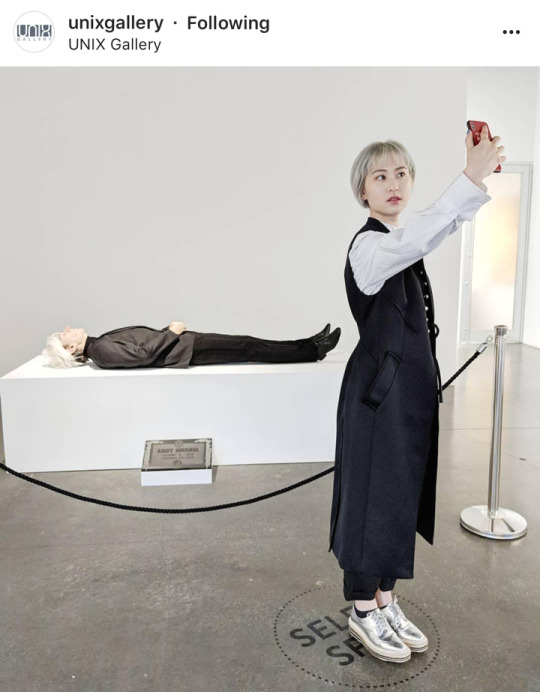
Here: A meta selfie posted by Unix Gallery in their “Here Died Warhol” exhibition, in anticipation of #GallerySelfieDay 2018.
7) The Mirror Selfie
Selfies and mirrors go together like a horse and carriage. Cliché? Not necessarily. Some ideas are used again and again because they work! Reflective surfaces - especially when part of the artworks themselves - often provide original views of the selfie-taker and her or his surroundings.

ADAA design intern Danielle Juliao with a reflective Olafur Eliasson work on view in Tanya Bonakdar Gallery’s Booth at The Art Show 2017.

ADAA Social Media Director Nicole Casamento posed friends in a reflective work by Nanda Vigo at Sperone Westwater, 2016.

For #GallerySelfieDay last year, Artwell Guide posted this self-portrait by Vivian Maier, a nanny whose street photography was discovered and celebrated after her death.
32 notes
·
View notes
Text
ADAA April San Francisco Exhibitions
Spencer Finch captures the evanescence of visual memories and the observed world in his first solo exhibition at Berggruen Gallery. Hiroshi Sugimoto depicts scenes of pre-historic life on earth in more than twenty works spanning the artist’s career at Fraenkel Gallery. Pace presents the first exhibition of pioneering artist Michal Rovner’s work in Palo Alto. Browse the full list below.
Altman Siegel: “Trevor Paglen: Impossible Objects” March 15 - May 5
Anglim Gilbert Gallery: “John Beech: Under Way” March 22 - April 21, “Lynn Hershman Leeson” April 26 - May 26
Berggruen Gallery: “Contemporary Works on Paper” & “Spencer Finch: Me, Myself, and I (A Group Show)” March 28 - May 5

Diana Al-Hadid, Untitled, 2013, Conte crayon, charcoal, pastel and acrylic on Mylar. Courtesy Berggruen Gallery, San Francisco.
Rena Bransten Gallery: “Oliver Lee Jackson: Someplace Else” March 3 - April 28
Crown Point Press: “Verdant Spring: A Group Exhibition” March 8 - April 28
Fraenkel Gallery: “Hiroshi Sugimoto: B.C.” March 8 - April 25
Haines Gallery: “Linda Connor & Zhan Wang: Speak to the Stones, and the Stars Answer” March 1 - June 2
Hosfelt Gallery: “Anoka Faruqee: structural color” & “Gideon Rubin: The Kaiser’s Daughter” March 17 - April 28
Modernism, Inc: “Jacques Villeglé: Traces: Décollages from 1956-2000″ March 15 - April 28

Jacques Villeglé, Raspail-Norte-Dame-Des-Champs - Colonne Morris Mai 1958, 1958, décollage mounted on canvas. Courtesy Modernism, Inc, San Francisco.
Anthony Meier Fine Arts: “Caragh Thuring” April 27 - June 1
Pace Palo Alto: “Michal Rovner: Evolution” March 9 - May 13
0 notes